Perspectives on the Youth Labour Market in Canada
Archived Content
Information identified as archived is provided for reference, research or recordkeeping purposes. It is not subject to the Government of Canada Web Standards and has not been altered or updated since it was archived. Please "contact us" to request a format other than those available.
Presentation to the National Statistics Council
April 2016
René Morissette
Social Analysis and Modelling Division
Analytical Studies Branch
The following presentation was given by Statistics Canada's Social Analysis and Modelling Division (SAMD) at the National Statistics Council Meeting in April 2016 to highlight recent research findings related to the youth labour market.
Following the 2008-to-2009 recession, concerns have been raised about the relatively high level of unemployment experienced by young individuals. This presentation shows how various labour market indicators have evolved for youth since the mid-1970s/early 1980s in Canada. A comparison is made with labour market indicators for older individuals. The degree to which specific groups of youth―the less educated ones versus the more highly educated, young recent immigrants and young Aboriginal people―have been successful in the Canadian labour market is assessed. A key finding is that while youth unemployment today is similar to that of the 1970s, job quality appears to have deteriorated for many young people.
Outline
I. (Un)employment, wages and wealth of youth over the past few decades
Unemployment has been historically higher for youth than for older workers

Description for Chart 1
Note: The circles highlight the fact that youth unemployment rates were at fairly similar levels in 2015 and during the mid-1970s
| Individuals under 25 | Individuals 25 and over | |
|---|---|---|
| Note: Prior to 1976, individuals under 25 included those aged 14 to 24. Since 1976, they include those aged 15 to 24. Sources: Labour Force Information, 71-001-X, December 1975; CANSIM table 282-0002 |
||
| 1953 | 4.5 | 2.5 |
| 1954 | 6.9 | 3.8 |
| 1955 | 6.7 | 3.7 |
| 1956 | 5.2 | 2.9 |
| 1957 | 7.3 | 3.9 |
| 1958 | 11.0 | 5.9 |
| 1959 | 9.4 | 5.0 |
| 1960 | 11.0 | 5.8 |
| 1961 | 10.9 | 6.1 |
| 1962 | 9.4 | 4.9 |
| 1963 | 9.3 | 4.5 |
| 1964 | 7.9 | 3.7 |
| 1965 | 6.5 | 3.1 |
| 1966 | 6.0 | 2.8 |
| 1967 | 6.8 | 3.2 |
| 1968 | 8.2 | 3.7 |
| 1969 | 7.9 | 3.6 |
| 1970 | 10.4 | 4.4 |
| 1971 | 11.4 | 4.7 |
| 1972 | 11.1 | 4.6 |
| 1973 | 10.0 | 4.0 |
| 1974 | 9.6 | 3.8 |
| 1975 | 12.5 | 5.0 |
| 1976 | 12.4 | 5.1 |
| 1977 | 13.8 | 5.8 |
| 1978 | 14 | 6.2 |
| 1979 | 12.7 | 5.6 |
| 1980 | 12.8 | 5.5 |
| 1981 | 12.8 | 5.7 |
| 1982 | 18.2 | 8.6 |
| 1983 | 19.2 | 9.6 |
| 1984 | 17.4 | 9.4 |
| 1985 | 15.8 | 8.9 |
| 1986 | 14.7 | 8.1 |
| 1987 | 13.2 | 7.6 |
| 1988 | 11.5 | 6.8 |
| 1989 | 10.9 | 6.7 |
| 1990 | 12.3 | 7.1 |
| 1991 | 15.8 | 9.1 |
| 1992 | 17.2 | 9.9 |
| 1993 | 17.2 | 10.2 |
| 1994 | 15.9 | 9.3 |
| 1995 | 14.8 | 8.4 |
| 1996 | 15.4 | 8.5 |
| 1997 | 16.3 | 7.7 |
| 1998 | 15.1 | 7 |
| 1999 | 14.1 | 6.3 |
| 2000 | 12.7 | 5.7 |
| 2001 | 12.9 | 6.1 |
| 2002 | 13.6 | 6.5 |
| 2003 | 13.6 | 6.4 |
| 2004 | 13.4 | 5.9 |
| 2005 | 12.4 | 5.7 |
| 2006 | 11.7 | 5.3 |
| 2007 | 11.2 | 5 |
| 2008 | 11.6 | 5.1 |
| 2009 | 15.4 | 7 |
| 2010 | 14.9 | 6.8 |
| 2011 | 14.3 | 6.3 |
| 2012 | 14.4 | 6 |
| 2013 | 13.7 | 5.9 |
| 2014 | 13.5 | 5.8 |
| 2015 | 13.2 | 5.8 |
Individuals under 25 had similar unemployment rates in 1976 and 2014, but lower full-time employment rates in 2014

Description for Chart 2
| U: Men 17 to 24 | FTE: Men 17 to 24 | U: Women 17 to 24 | FTE: Women 17 to 24 | |
|---|---|---|---|---|
| Sources: Economic Insights, 11-626-X, no. 49, July 2015; Labour Force Survey. | ||||
| 1976 | 13.5 | 76.8 | 11.8 | 58.7 |
| 2014 | 14.3 | 59.1 | 11.2 | 48.0 |
The drop in full-time employment rates was observed among men of all ages and among women under 25

Description for Chart 3
| 17 to 24 years | 25 to 29 years | 30 to 54 years | |
|---|---|---|---|
| Sources: Economic Insights, 11-626-X, no. 49, July 2015; Labour Force Survey. | |||
| 1976 | 76.8 | 89.1 | 90.0 |
| 1977 | 75.3 | 87.5 | 89.0 |
| 1978 | 75.5 | 88.1 | 88.9 |
| 1979 | 77.2 | 88.1 | 89.6 |
| 1980 | 76.4 | 87.6 | 89.0 |
| 1981 | 75.4 | 87.0 | 89.0 |
| 1982 | 64.7 | 81.0 | 84.9 |
| 1983 | 62.5 | 78.5 | 83.6 |
| 1984 | 64.9 | 79.4 | 83.7 |
| 1985 | 67.3 | 81.3 | 84.4 |
| 1986 | 68.9 | 81.6 | 85.5 |
| 1987 | 71.7 | 83.5 | 86.1 |
| 1988 | 73.3 | 84.9 | 86.7 |
| 1989 | 74.1 | 85.0 | 86.5 |
| 1990 | 70.5 | 82.8 | 85.3 |
| 1991 | 62.6 | 77.9 | 82.7 |
| 1992 | 59.1 | 75.9 | 80.7 |
| 1993 | 57.6 | 75.4 | 80.3 |
| 1994 | 60.0 | 77.2 | 81.0 |
| 1995 | 61.4 | 78.4 | 81.4 |
| 1996 | 60.9 | 78.5 | 80.8 |
| 1997 | 62.3 | 79.4 | 81.6 |
| 1998 | 62.3 | 81.1 | 82.3 |
| 1999 | 64.9 | 82.5 | 82.9 |
| 2000 | 66.2 | 83.7 | 83.5 |
| 2001 | 65.5 | 82.0 | 83.0 |
| 2002 | 64.6 | 81.5 | 82.7 |
| 2003 | 64.1 | 82.2 | 83.1 |
| 2004 | 64.5 | 81.2 | 83.9 |
| 2005 | 65.1 | 82.6 | 83.8 |
| 2006 | 66.2 | 83.1 | 83.9 |
| 2007 | 67.6 | 82.8 | 84.0 |
| 2008 | 65.6 | 83.2 | 83.9 |
| 2009 | 59.6 | 79.0 | 80.9 |
| 2010 | 59.0 | 79.4 | 81.1 |
| 2011 | 59.6 | 79.4 | 82.2 |
| 2012 | 60.0 | 80.3 | 82.6 |
| 2013 | 59.8 | 79.4 | 82.6 |
| 2014 | 59.1 | 78.8 | 82.6 |
| 17 to 24 years | 25 to 29 years | 30 to 54 years | |
|---|---|---|---|
| Sources: Economic Insights, 11-626-X, no. 49, July 2015; Labour Force Survey. | |||
| 1976 | 58.7 | 44.3 | 36.1 |
| 1977 | 58.0 | 44.9 | 36.6 |
| 1978 | 58.2 | 47.3 | 38.0 |
| 1979 | 59.2 | 48.9 | 39.3 |
| 1980 | 60.4 | 50.5 | 40.6 |
| 1981 | 60.5 | 51.2 | 42.5 |
| 1982 | 54.5 | 50.7 | 42.0 |
| 1983 | 53.5 | 51.9 | 42.4 |
| 1984 | 54.0 | 52.4 | 44.4 |
| 1985 | 55.8 | 53.3 | 45.8 |
| 1986 | 57.4 | 56.2 | 47.7 |
| 1987 | 59.4 | 56.9 | 49.6 |
| 1988 | 60.9 | 58.8 | 51.2 |
| 1989 | 61.7 | 60.4 | 53.0 |
| 1990 | 59.8 | 60.5 | 53.9 |
| 1991 | 55.2 | 59.3 | 53.1 |
| 1992 | 52.0 | 58.4 | 52.8 |
| 1993 | 48.9 | 56.7 | 52.8 |
| 1994 | 48.8 | 58.4 | 53.3 |
| 1995 | 48.8 | 57.5 | 54.4 |
| 1996 | 46.6 | 57.8 | 54.0 |
| 1997 | 45.6 | 59.1 | 54.7 |
| 1998 | 47.7 | 61.1 | 56.2 |
| 1999 | 51.2 | 62.5 | 57.4 |
| 2000 | 52.8 | 63.5 | 58.6 |
| 2001 | 54.0 | 64.9 | 58.9 |
| 2002 | 53.0 | 64.9 | 59.9 |
| 2003 | 53.0 | 65.9 | 60.4 |
| 2004 | 53.4 | 66.2 | 61.6 |
| 2005 | 54.2 | 66.5 | 61.8 |
| 2006 | 55.8 | 68.0 | 62.6 |
| 2007 | 54.9 | 68.3 | 64.1 |
| 2008 | 54.8 | 68.1 | 63.8 |
| 2009 | 50.3 | 65.9 | 62.9 |
| 2010 | 48.9 | 65.5 | 62.7 |
| 2011 | 49.7 | 64.9 | 63.4 |
| 2012 | 48.7 | 65.1 | 64.0 |
| 2013 | 49.0 | 65.6 | 64.5 |
| 2014 | 48.0 | 64.9 | 64.1 |
The increased incidence of part-time employment drove most of the decline in the full-time employment rate of individuals under 25
| Men 17 to 24 |
Women 17 to 24 |
Men 25 to 29 |
Men 30 to 54 |
|
|---|---|---|---|---|
| Sources: Economic Insights, 11-626-X, no. 49, July 2015; Labour Force Survey. | ||||
| Changes in full-time employment rate, 1976 to 2014 (percentage points) | -17.7 | -10.7 | -10.2 | -7.5 |
| Sources of decline (%): | ||||
| Participation | 23.8 | -58.1 | 35.7 | 39.5 |
| Unemployment | 3.7 | -3.3 | 21.7 | 19.7 |
| Part-time employment | 72.5 | 161.3 | 42.5 | 40.8 |
| Total | 100.0 | 100.0 | 100.0 | 100.0 |
The drop in full-time employment rates was also observed among young individuals with a university degree (except women aged 25 to 29)

Description for Chart 4
| Men 17 to 24 | Men 25 to 29 | Women 17 to 24 | Women 25 to 29 | |
|---|---|---|---|---|
| Sources: Economic Insights, 11-626-X, no. 49, July 2015; Labour Force Survey. | ||||
| No university degree | -18.1 | -10.9 | -11.9 | 17.7 |
| University degree | -16.6 | -9.6 | -16.2 | 8.7 |
When they have full-time jobs, youth are now more likely to be in temporary jobs than in the past

Description for Chart 5
| 15 to 24 years | 25 to 34 years | 35 to 54 years | |
|---|---|---|---|
| Sources: Updated from Insights on Canadian Society, 75-006X, July 2013; 1989 General Social Survey; Labour Force Survey. | |||
| 1989 | 7.4 | 4.8 | 2.1 |
| 1997 | 22.0 | 8.5 | 5.8 |
| 2014 | 24.1 | 10.3 | 6.7 |
| 15 to 24 years | 25 to 34 years | 35 to 54 years | |
|---|---|---|---|
| Sources: Updated from Insights on Canadian Society, 75-006X, July 2013; 1989 General Social Survey; Labour Force Survey. | |||
| 1989 | 7.8 | 3.0 | 3.4 |
| 1997 | 20.6 | 8.0 | 6.0 |
| 2014 | 26.0 | 10.7 | 6.2 |
Despite rising education levels, real wages grew little during the 1980s and 1990s

Description for Chart 6
| % with university degree | ||
|---|---|---|
| Note: The circles highlight the fact that even though the percentage of full-time employees with a university degree has increased substantially from 1980 to 2000 (left chart), median wages grew only 5% during that period (right chart). Sources: Updated from Analytical Studies Branch Research Paper Series, 11F0019M, No. 347, March 2013; Census of Population, Labour Force Survey, 1981 Survey of Work History, 1984 Survey of Union Membership, Labour Market Activity Survey, 1986 to 1990 |
||
| 1976 | 11.0 | |
| 1977 | 11.3 | |
| 1978 | 11.7 | |
| 1979 | 11.9 | |
| 1980 | 12.2 | |
| 1981 | 12.6 | |
| 1982 | 13.3 | |
| 1983 | 14.5 | |
| 1984 | 14.9 | |
| 1985 | 15.1 | |
| 1986 | 15.1 | |
| 1987 | 15.9 | |
| 1988 | 16.8 | |
| 1989 | 17.0 | |
| 1990 | 15.6 | |
| 1991 | 16.3 | |
| 1992 | 17.3 | |
| 1993 | 18.6 | |
| 1994 | 19.1 | |
| 1995 | 19.4 | |
| 1996 | 19.3 | |
| 1997 | 19.5 | |
| 1998 | 19.9 | |
| 1999 | 20.4 | |
| 2000 | 20.9 | |
| 2001 | 21.6 | |
| 2002 | 21.8 | |
| 2003 | 21.9 | |
| 2004 | 22.4 | |
| 2005 | 23.4 | |
| 2006 | 24.3 | |
| 2007 | 24.9 | |
| 2008 | 25.3 | |
| 2009 | 26.4 | |
| 2010 | 27.1 | |
| 2011 | 27.2 | |
| 2012 | 28.4 | |
| 2013 | 28.9 | |
| 2014 | 29.2 | |
| median weekly wages | median hourly wages | |
|---|---|---|
Sources: Updated from Analytical Studies Branch Research Paper Series, 11F0019M, No. 347, March 2013; Census of Population, Labour Force Survey, 1981 Survey of Work History, 1984 Survey of Union Membership, Labour Market Activity Survey, 1986 to 1990 |
||
| 1980 | 100.2 | - |
| 1981 | 100.0Chart 6b Note 2 | 100.0 |
| 1982 | 99.8Chart 6b Note 2 | 101.5Chart 6b Note 1 |
| 1983 | 99.6Chart 6b Note 2 | 103.0Chart 6b Note 1 |
| 1984 | 99.5Chart 6b Note 2 | 104.4 |
| 1985 | 99.3 | 102.8Chart 6b Note 1 |
| 1986 | 100.0Chart 6b Note 2 | 101.2 |
| 1987 | 100.7Chart 6b Note 2 | 101.7 |
| 1989 | 101.4Chart 6b Note 2 | 103.7 |
| 1989 | 102.1Chart 6b Note 2 | 102.3 |
| 1990 | 102.8 | 102.5 |
| 1991 | 102.5Chart 6b Note 2 | 102.6Chart 6b Note 1 |
| 1992 | 102.2Chart 6b Note 2 | 102.8Chart 6b Note 1 |
| 1993 | 102.0Chart 6b Note 2 | 103.0Chart 6b Note 1 |
| 1994 | 101.7Chart 6b Note 2 | 103.1Chart 6b Note 1 |
| 1995 | 101.4 | 103.3Chart 6b Note 1 |
| 1996 | 102.1Chart 6b Note 2 | 103.5Chart 6b Note 1 |
| 1997 | 102.9Chart 6b Note 2 | 103.6 |
| 1998 | 103.6Chart 6b Note 2 | 104.2 |
| 1999 | 104.4Chart 6b Note 2 | 104.1 |
| 2000 | 105.1 | 104.6 |
| 2001 | 106.2 | 106.0 |
| 2002 | 104.8 | 105.5 |
| 2003 | 104.8 | 104.5 |
| 2004 | 104.6 | 105.4 |
| 2005 | 104.7 | 104.5 |
| 2006 | 106.9 | 106.0 |
| 2007 | 107.4 | 106.8 |
| 2008 | 109.1 | 109.4 |
| 2009 | 110.2 | 110.9 |
| 2010 | 112.2 | 112.4 |
| 2011 | 111.5 | 110.6 |
| 2012 | 112.5 | 112.3 |
| 2013 | 114.1 | 114.1 |
| 2014 | 114.4 | 113.7 |
The wages of young full-time employees, especially employees under 25, have fallen since the early 1980s, compared with those of older employees

Description for Chart 7
| 17-24 | 25-34 | 35-44 | 45-54 | |
|---|---|---|---|---|
|
||||
| 1981 | 100.0 | 100.0 | 100.0 | 100.0 |
| 96.8Chart 7 Note 1 | 100.5Chart 7 Note 1 | 102.6Chart 7 Note 1 | 103.7Chart 7 Note 1 | |
| 93.7Chart 7 Note 1 | 100.9Chart 7 Note 1 | 105.1Chart 7 Note 1 | 107.5Chart 7 Note 1 | |
| 1984 | 90.5 | 101.4 | 107.7 | 111.2 |
| 86.6Chart 7 Note 1 | 97.7Chart 7 Note 1 | 106.6Chart 7 Note 1 | 112.5Chart 7 Note 1 | |
| 1986 | 82.6 | 94.1 | 105.5 | 113.8 |
| 1987 | 83.9 | 95.1 | 104.1 | 114.6 |
| 1988 | 87.6 | 97.1 | 107.7 | 114.9 |
| 1989 | 84.7 | 94.7 | 105.5 | 113.2 |
| 1990 | 84.2 | 94.0 | 104.0 | 113.4 |
| 83.4Chart 7 Note 1 | 93.2Chart 7 Note 1 | 103.4Chart 7 Note 1 | 113.7Chart 7 Note 1 | |
| 82.5Chart 7 Note 1 | 92.4Chart 7 Note 1 | 102.9Chart 7 Note 1 | 114.0Chart 7 Note 1 | |
| 81.7Chart 7 Note 1 | 91.5Chart 7 Note 1 | 102.3Chart 7 Note 1 | 114.2Chart 7 Note 1 | |
| 80.9Chart 7 Note 1 | 90.7Chart 7 Note 1 | 101.8Chart 7 Note 1 | 114.5Chart 7 Note 1 | |
| 80.1Chart 7 Note 1 | 89.9Chart 7 Note 1 | 101.2Chart 7 Note 1 | 114.8Chart 7 Note 1 | |
| 79.3Chart 7 Note 1 | 89.1Chart 7 Note 1 | 100.7Chart 7 Note 1 | 115.1Chart 7 Note 1 | |
| 1997 | 78.4 | 88.3 | 100.1 | 115.4 |
| 1998 | 77.8 | 89.5 | 99.0 | 114.3 |
| 1999 | 79.3 | 89.0 | 98.9 | 114.9 |
| 2000 | 78.0 | 92.3 | 98.2 | 114.4 |
| 2001 | 83.2 | 92.4 | 99.4 | 114.3 |
| 2002 | 81.6 | 91.7 | 97.4 | 114.0 |
| 2003 | 79.8 | 90.0 | 95.0 | 111.2 |
| 2004 | 78.0 | 90.3 | 96.7 | 111.1 |
| 2005 | 82.3 | 90.4 | 96.2 | 110.2 |
| 2006 | 81.9 | 94.0 | 98.5 | 109.5 |
| 2007 | 87.0 | 94.2 | 100.5 | 111.3 |
| 2008 | 87.6 | 94.2 | 102.5 | 110.9 |
| 2009 | 91.3 | 97.6 | 107.0 | 113.9 |
| 2010 | 89.1 | 98.5 | 104.5 | 113.6 |
| 2011 | 87.8 | 97.9 | 101.4 | 112.0 |
| 2012 | 88.3 | 98.1 | 103.3 | 112.0 |
| 2013 | 90.4 | 102.5 | 105.9 | 114.9 |
| 2014 | 88.8 | 100.9 | 104.4 | 113.3 |
| 17-24 | 25-34 | 35-44 | 45-54 | |
|---|---|---|---|---|
|
||||
| 1981 | 100.0 | 100.0 | 100.0 | 100.0 |
| 97.5Chart 7 Note 1 | 100.8Chart 7 Note 1 | 101.2Chart 7 Note 1 | 101.5Chart 7 Note 1 | |
| 94.9Chart 7 Note 1 | 101.6Chart 7 Note 1 | 102.3Chart 7 Note 1 | 103.0Chart 7 Note 1 | |
| 1984 | 92.4 | 102.4 | 103.5 | 104.5 |
| 87.6Chart 7 Note 1 | 101.6Chart 7 Note 1 | 104.5Chart 7 Note 1 | 105.6Chart 7 Note 1 | |
| 1986 | 82.7 | 100.9 | 105.4 | 106.7 |
| 1987 | 85.2 | 99.6 | 104.6 | 106.4 |
| 1988 | 92.4 | 99.2 | 106.6 | 104.8 |
| 1989 | 85.6 | 99.9 | 106.2 | 105.7 |
| 1990 | 88.6 | 99.5 | 104.9 | 106.8 |
| 87.7Chart 7 Note 1 | 99.6Chart 7 Note 1 | 106.0Chart 7 Note 1 | 109.1Chart 7 Note 1 | |
| 86.7Chart 7 Note 1 | 99.7Chart 7 Note 1 | 107.1Chart 7 Note 1 | 111.4Chart 7 Note 1 | |
| 85.7Chart 7 Note 1 | 99.8Chart 7 Note 1 | 108.2Chart 7 Note 1 | 113.7Chart 7 Note 1 | |
| 84.8Chart 7 Note 1 | 99.9Chart 7 Note 1 | 109.3Chart 7 Note 1 | 116.0Chart 7 Note 1 | |
| 83.8Chart 7 Note 1 | 100.0Chart 7 Note 1 | 110.4Chart 7 Note 1 | 118.3Chart 7 Note 1 | |
| 82.8Chart 7 Note 1 | 100.1Chart 7 Note 1 | 111.5Chart 7 Note 1 | 120.6Chart 7 Note 1 | |
| 1997 | 81.9 | 100.2 | 112.6 | 122.9 |
| 1998 | 81.2 | 101.9 | 111.0 | 120.2 |
| 1999 | 84.7 | 101.9 | 110.6 | 122.6 |
| 2000 | 83.2 | 103.1 | 110.2 | 122.9 |
| 2001 | 85.3 | 104.1 | 111.3 | 121.3 |
| 2002 | 88.0 | 104.6 | 110.6 | 123.1 |
| 2003 | 85.6 | 106.0 | 112.8 | 119.7 |
| 2004 | 84.1 | 105.6 | 112.5 | 123.8 |
| 2005 | 82.7 | 105.2 | 113.5 | 124.6 |
| 2006 | 88.3 | 106.4 | 114.4 | 123.7 |
| 2007 | 87.6 | 107.9 | 113.5 | 127.4 |
| 2008 | 93.1 | 110.7 | 120.3 | 126.0 |
| 2009 | 97.7 | 114.8 | 123.7 | 128.9 |
| 2010 | 92.7 | 112.3 | 124.7 | 130.1 |
| 2011 | 95.2 | 110.6 | 122.9 | 129.4 |
| 2012 | 93.8 | 112.8 | 125.1 | 129.5 |
| 2013 | 96.0 | 116.3 | 127.9 | 132.3 |
| 2014 | 94.3 | 115.8 | 128.9 | 132.2 |
The wage ratio for bachelor's degree holders increased from 1980 to 2000 and fell afterwards
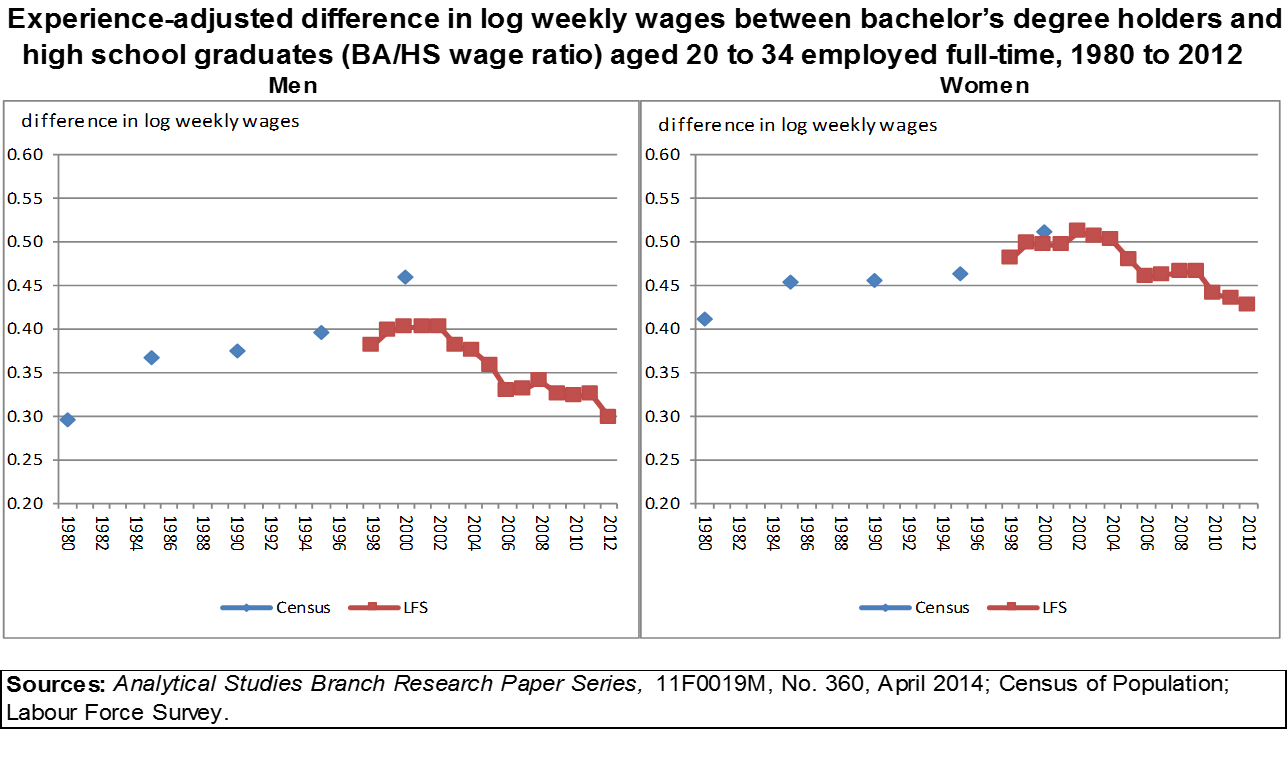
Description for Chart 8
| Census | LFS | |
|---|---|---|
| Source: Analytical Studies Branch Research Paper Series, 11F0019M, No. 360, April 2014; Census of Population and Labour Force Survey | ||
| 1980 | 0.295 | not applicable ... |
| 1981 | not applicable ... | not applicable ... |
| 1982 | not applicable ... | not applicable ... |
| 1983 | not applicable ... | not applicable ... |
| 1984 | not applicable ... | not applicable ... |
| 1985 | 0.367 | not applicable ... |
| 1986 | not applicable ... | not applicable ... |
| 1987 | not applicable ... | not applicable ... |
| 1988 | not applicable ... | not applicable ... |
| 1989 | not applicable ... | not applicable ... |
| 1990 | 0.374 | not applicable ... |
| 1991 | not applicable ... | not applicable ... |
| 1992 | not applicable ... | not applicable ... |
| 1993 | not applicable ... | not applicable ... |
| 1994 | not applicable ... | not applicable ... |
| 1995 | 0.396 | not applicable ... |
| 1996 | not applicable ... | not applicable ... |
| 1997 | not applicable ... | not applicable ... |
| 1998 | not applicable ... | 0.380 |
| 1999 | not applicable ... | 0.397 |
| 2000 | 0.460 | 0.401 |
| 2001 | not applicable ... | 0.402 |
| 2002 | not applicable ... | 0.402 |
| 2003 | not applicable ... | 0.380 |
| 2004 | not applicable ... | 0.374 |
| 2005 | not applicable ... | 0.357 |
| 2006 | not applicable ... | 0.328 |
| 2007 | not applicable ... | 0.331 |
| 2008 | not applicable ... | 0.340 |
| 2009 | not applicable ... | 0.325 |
| 2010 | not applicable ... | 0.322 |
| 2011 | not applicable ... | 0.325 |
| 2012 | not applicable ... | 0.297 |
| Census | LFS | |
|---|---|---|
| Source: Analytical Studies Branch Research Paper Series, 11F0019M, No. 360, April 2014; Census of Population and Labour Force Survey | ||
| 1980 | 0.411 | not applicable ... |
| 1981 | not applicable ... | not applicable ... |
| 1982 | not applicable ... | not applicable ... |
| 1983 | not applicable ... | not applicable ... |
| 1984 | not applicable ... | not applicable ... |
| 1985 | 0.454 | not applicable ... |
| 1986 | not applicable ... | not applicable ... |
| 1987 | not applicable ... | not applicable ... |
| 1988 | not applicable ... | not applicable ... |
| 1989 | not applicable ... | not applicable ... |
| 1990 | 0.455 | not applicable ... |
| 1991 | not applicable ... | not applicable ... |
| 1992 | not applicable ... | not applicable ... |
| 1993 | not applicable ... | not applicable ... |
| 1994 | not applicable ... | not applicable ... |
| 1995 | 0.463 | not applicable ... |
| 1996 | not applicable ... | not applicable ... |
| 1997 | not applicable ... | not applicable ... |
| 1998 | not applicable ... | 0.481 |
| 1999 | not applicable ... | 0.499 |
| 2000 | 0.512 | 0.496 |
| 2001 | not applicable ... | 0.496 |
| 2002 | not applicable ... | 0.511 |
| 2003 | not applicable ... | 0.507 |
| 2004 | not applicable ... | 0.501 |
| 2005 | not applicable ... | 0.478 |
| 2006 | not applicable ... | 0.460 |
| 2007 | not applicable ... | 0.462 |
| 2008 | not applicable ... | 0.465 |
| 2009 | not applicable ... | 0.465 |
| 2010 | not applicable ... | 0.441 |
| 2011 | not applicable ... | 0.435 |
| 2012 | not applicable ... | 0.428 |
Part of the narrowing of the wage ratio for young women was associated with increased real minimum wages
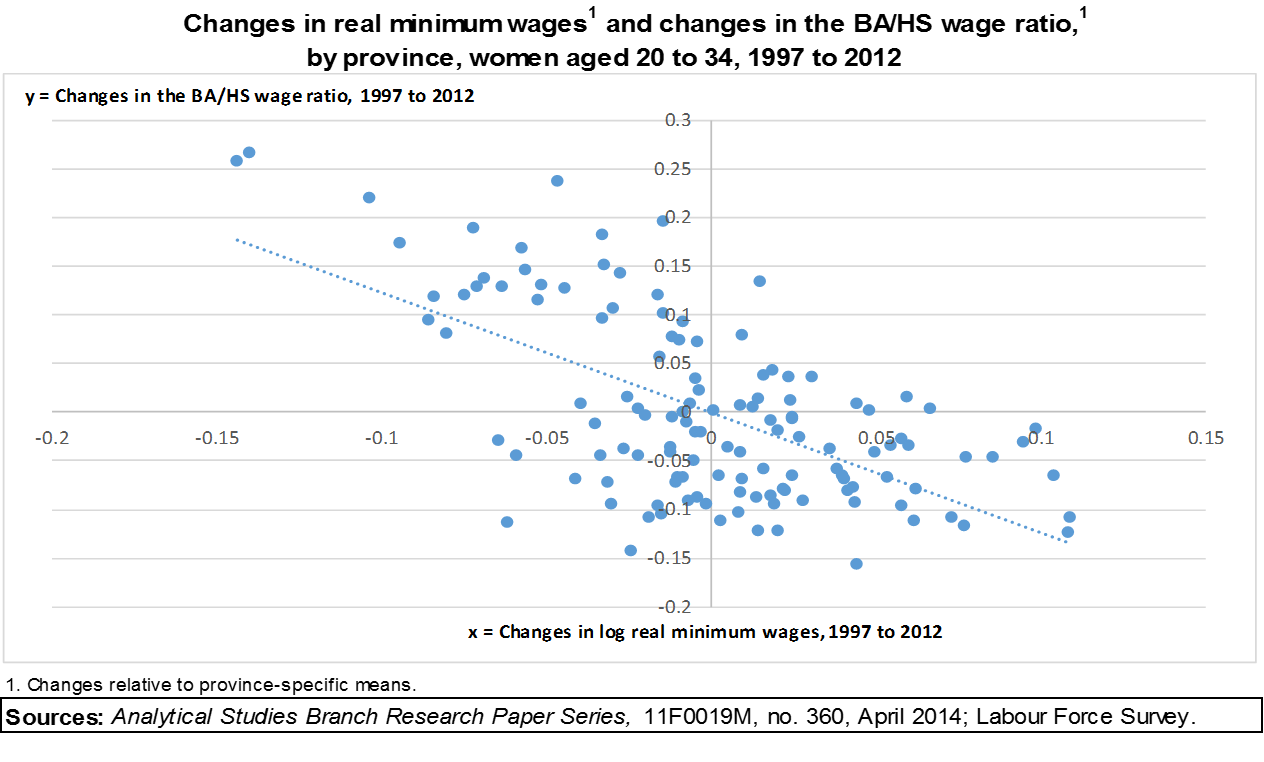
Description for Chart 9
| Year | Changes in the BA/high school wage ratio, 1997 to 2012 | Changes in log real minimum wages, 1997 to 2012 |
|---|---|---|
|
||
| 1997 | 0.107983 | -0.12325 |
| 1998 | -0.06202 | -0.11344 |
| 1999 | 0.076818 | -0.11556 |
| 2000 | 0.061507 | -0.11029 |
| 2001 | 0.0204 | -0.12161 |
| 2002 | 0.108528 | -0.1077 |
| 2003 | -0.00411 | -0.08645 |
| 2004 | -0.01494 | -0.10475 |
| 2005 | -0.01875 | -0.1071 |
| 2006 | 0.085561 | -0.04639 |
| 2007 | -0.00651 | 0.008723 |
| 2008 | 0.009343 | 0.08041 |
| 2009 | -0.03303 | 0.18315 |
| 2010 | -0.1402 | 0.267224 |
| 2011 | -0.14378 | 0.259038 |
| 2012 | -0.0468 | 0.237994 |
| 1997 | -0.01018 | -0.06716 |
| 1998 | 0.039782 | -0.06378 |
| 1999 | 0.061938 | -0.07764 |
| 2000 | 0.041232 | -0.07934 |
| 2001 | 0.022117 | -0.08001 |
| 2002 | 0.013552 | -0.08672 |
| 2003 | -0.03057 | -0.09425 |
| 2004 | 0.009554 | -0.0673 |
| 2005 | -0.04141 | -0.06817 |
| 2006 | 0.054174 | -0.03288 |
| 2007 | 0.04393 | 0.009235 |
| 2008 | 0.018324 | 0.044186 |
| 2009 | -0.01433 | 0.101369 |
| 2010 | -0.03243 | 0.152561 |
| 2011 | -0.07217 | 0.189473 |
| 2012 | -0.10353 | 0.220412 |
| 1997 | -0.02231 | 0.00359 |
| 1998 | 0.066198 | 0.004135 |
| 1999 | -0.00839 | -2.2E-05 |
| 2000 | 0.026813 | -0.02432 |
| 2001 | 0.059778 | -0.03383 |
| 2002 | 0.077146 | -0.04572 |
| 2003 | 0.036174 | -0.03671 |
| 2004 | 0.008971 | -0.04129 |
| 2005 | -0.05911 | -0.04393 |
| 2006 | -0.01219 | -0.04095 |
| 2007 | -0.06443 | -0.02872 |
| 2008 | 0.048024 | 0.001952 |
| 2009 | -0.02567 | 0.015562 |
| 2010 | -0.01177 | 0.0788 |
| 2011 | -0.08596 | 0.094957 |
| 2012 | -0.03327 | 0.096513 |
| 1997 | -0.00368 | 0.022715 |
| 1998 | 0.014005 | 0.013846 |
| 1999 | 0.024666 | -0.00583 |
| 2000 | -0.01218 | -0.03463 |
| 2001 | 0.001991 | -0.06467 |
| 2002 | 0.018156 | -0.08487 |
| 2003 | 0.002682 | -0.11151 |
| 2004 | 0.027927 | -0.09048 |
| 2005 | -0.03155 | -0.07099 |
| 2006 | -0.0054 | -0.049 |
| 2007 | 0.004974 | -0.03484 |
| 2008 | 0.023945 | 0.013405 |
| 2009 | -0.00838 | 0.093846 |
| 2010 | -0.05616 | 0.146976 |
| 2011 | 0.014975 | 0.135005 |
| 2012 | -0.01597 | 0.121024 |
| 1997 | -0.02443 | -0.14209 |
| 1998 | 0.044158 | -0.15524 |
| 1999 | -0.00181 | -0.09462 |
| 2000 | 0.019131 | -0.09358 |
| 2001 | -0.00712 | -0.08956 |
| 2002 | 0.024355 | -0.06506 |
| 2003 | -0.03385 | -0.0448 |
| 2004 | 0.057752 | -0.02756 |
| 2005 | 0.020159 | -0.01877 |
| 2006 | 0.01256 | 0.005945 |
| 2007 | 0.023357 | 0.036203 |
| 2008 | -0.00441 | 0.072298 |
| 2009 | -0.02971 | 0.107563 |
| 2010 | -0.02765 | 0.144055 |
| 2011 | -0.05767 | 0.168264 |
| 2012 | -0.01482 | 0.196947 |
| 1997 | 0.021893 | -0.07816 |
| 1998 | 0.043491 | -0.09152 |
| 1999 | 0.04953 | -0.04007 |
| 2000 | -0.00846 | -0.06582 |
| 2001 | 0.057646 | -0.09505 |
| 2002 | 0.042983 | -0.07731 |
| 2003 | -0.02198 | -0.04333 |
| 2004 | 0.053259 | -0.06557 |
| 2005 | 0.040051 | -0.06747 |
| 2006 | 0.008595 | 0.008142 |
| 2007 | -0.00464 | 0.034426 |
| 2008 | -0.00974 | 0.075334 |
| 2009 | -0.04455 | 0.127851 |
| 2010 | -0.06891 | 0.137982 |
| 2011 | -0.08406 | 0.119529 |
| 2012 | -0.07511 | 0.121042 |
| 1997 | 0.007965 | -0.10273 |
| 1998 | -0.01604 | -0.09533 |
| 1999 | 0.098536 | -0.01728 |
| 2000 | 0.01824 | -0.00734 |
| 2001 | 0.094768 | -0.03035 |
| 2002 | 0.10388 | -0.06391 |
| 2003 | 0.073065 | -0.10697 |
| 2004 | 0.014249 | -0.12124 |
| 2005 | 0.00887 | -0.08151 |
| 2006 | -0.00759 | -0.00896 |
| 2007 | -0.03542 | -0.0111 |
| 2008 | -0.08009 | 0.081825 |
| 2009 | -0.0713 | 0.129715 |
| 2010 | -0.05141 | 0.131316 |
| 2011 | -0.06353 | 0.129633 |
| 2012 | -0.09419 | 0.174234 |
| 1997 | -0.01178 | -0.00424 |
| 1998 | -0.03932 | 0.008486 |
| 1999 | 0.000445 | 0.003094 |
| 2000 | 0.02445 | -0.00432 |
| 2001 | 0.015748 | 0.038504 |
| 2002 | -0.01585 | 0.057795 |
| 2003 | 0.030555 | 0.036033 |
| 2004 | 0.059495 | 0.016653 |
| 2005 | -0.01995 | -0.0033 |
| 2006 | -0.0048 | -0.02009 |
| 2007 | -0.02677 | -0.03752 |
| 2008 | 0.015928 | -0.05821 |
| 2009 | 0.038129 | -0.05821 |
| 2010 | -0.01054 | -0.07148 |
| 2011 | -0.00319 | -0.0197 |
| 2012 | -0.05257 | 0.116503 |
Like older men, young men have experienced a decline in pension coverage
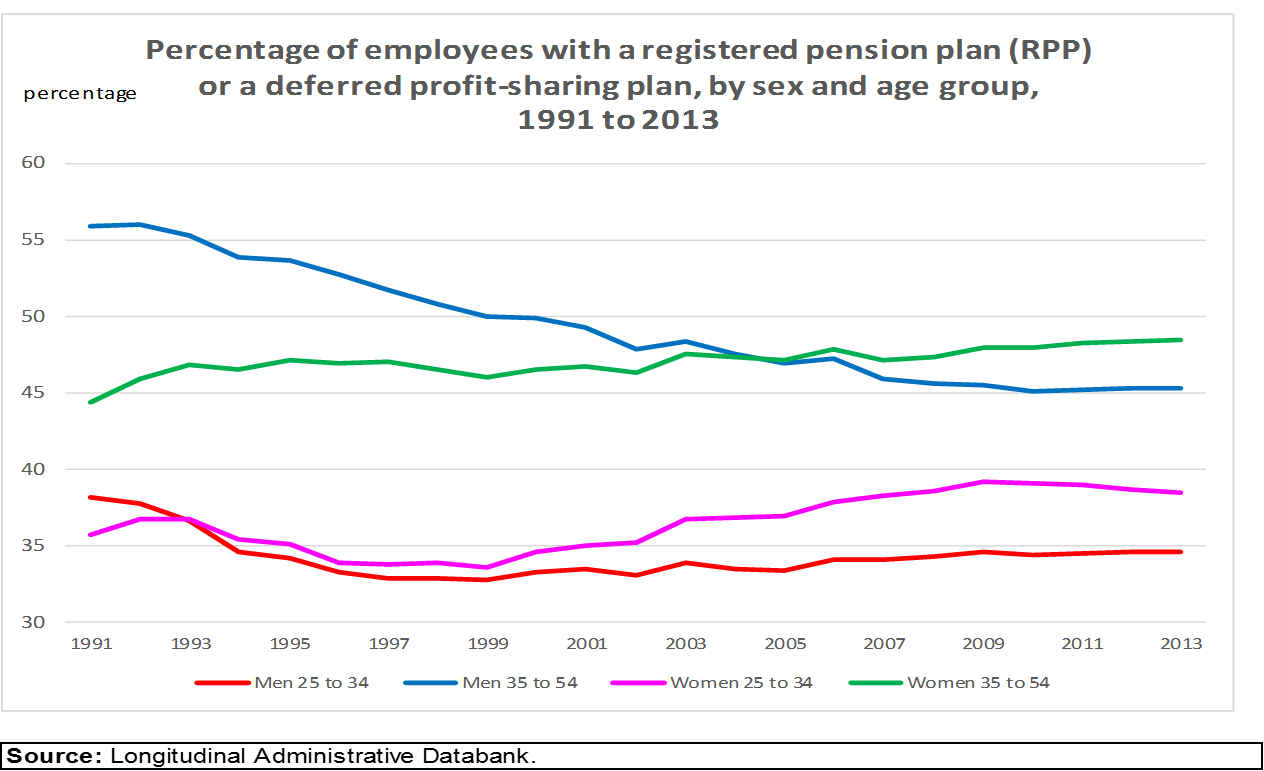
Description for Chart 10
| Year | Men | Women | ||
|---|---|---|---|---|
| 25 to 34 | 35 to 54 | 25 to 34 | 35 to 54 | |
| Source: Longitudinal Administrative Databank (LAD). | ||||
| 1991 | 38.2 | 55.9 | 35.8 | 44.3 |
| 1992 | 37.8 | 56.0 | 36.7 | 45.9 |
| 1993 | 36.6 | 55.3 | 36.8 | 46.8 |
| 1994 | 34.6 | 53.8 | 35.4 | 46.5 |
| 1995 | 34.2 | 53.6 | 35.1 | 47.1 |
| 1996 | 33.3 | 52.7 | 33.9 | 46.9 |
| 1997 | 32.9 | 51.7 | 33.8 | 47.0 |
| 1998 | 32.9 | 50.8 | 33.9 | 46.5 |
| 1999 | 32.8 | 50.0 | 33.6 | 46.0 |
| 2000 | 33.3 | 49.8 | 34.6 | 46.5 |
| 2001 | 33.5 | 49.2 | 35.0 | 46.8 |
| 2002 | 33.0 | 47.8 | 35.2 | 46.4 |
| 2003 | 33.9 | 48.3 | 36.7 | 47.5 |
| 2004 | 33.5 | 47.5 | 36.8 | 47.4 |
| 2005 | 33.4 | 46.9 | 37.0 | 47.2 |
| 2006 | 34.1 | 47.2 | 37.9 | 47.9 |
| 2007 | 34.1 | 45.9 | 38.2 | 47.1 |
| 2008 | 34.3 | 45.6 | 38.5 | 47.3 |
| 2009 | 34.5 | 45.5 | 39.2 | 47.9 |
| 2010 | 34.4 | 45.1 | 39.1 | 47.9 |
| 2011 | 34.5 | 45.2 | 39.0 | 48.2 |
| 2012 | 34.6 | 45.3 | 38.6 | 48.3 |
| 2013 | 34.6 | 45.3 | 38.4 | 48.5 |
Young individuals have lower net wealth than their counterparts had in the early 1980s
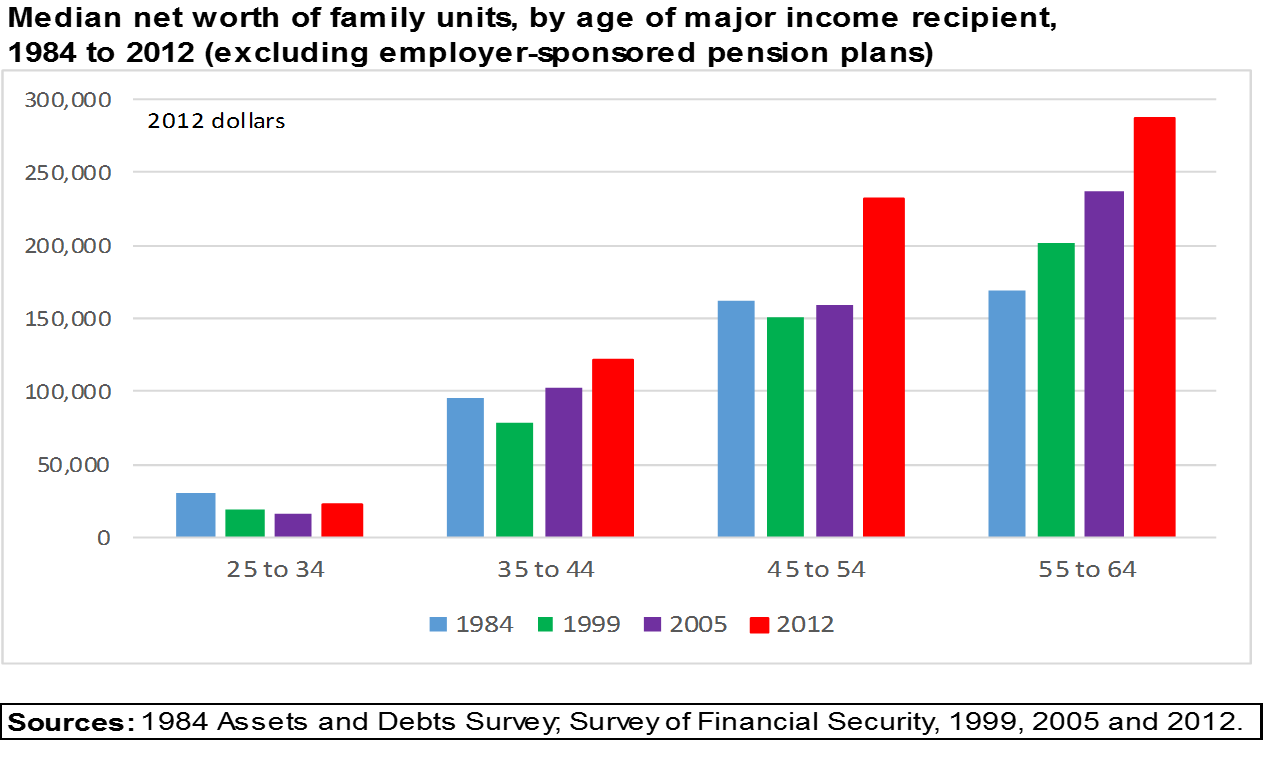
Description for Chart 11
| 1984 | 1999 | 2005 | 2012 | |
|---|---|---|---|---|
| Sources: 1984 Assets and Debts Survey; Survey of Financial Security of 1999, 2005 and 2012 | ||||
| 25 to 34 | 30,656 | 19,781 | 16,492 | 22,700 |
| 35 to 44 | 96,296 | 78,601 | 103,131 | 121,300 |
| 45 to 54 | 162,467 | 150,913 | 159,347 | 232,100 |
| 55 to 64 | 169,155 | 201,892 | 237,144 | 287,378 |
II. The oil boom of the 2000s
In terms of employment, youth in oil-producing provinces generally fared better than those in non-oil-producing provinces
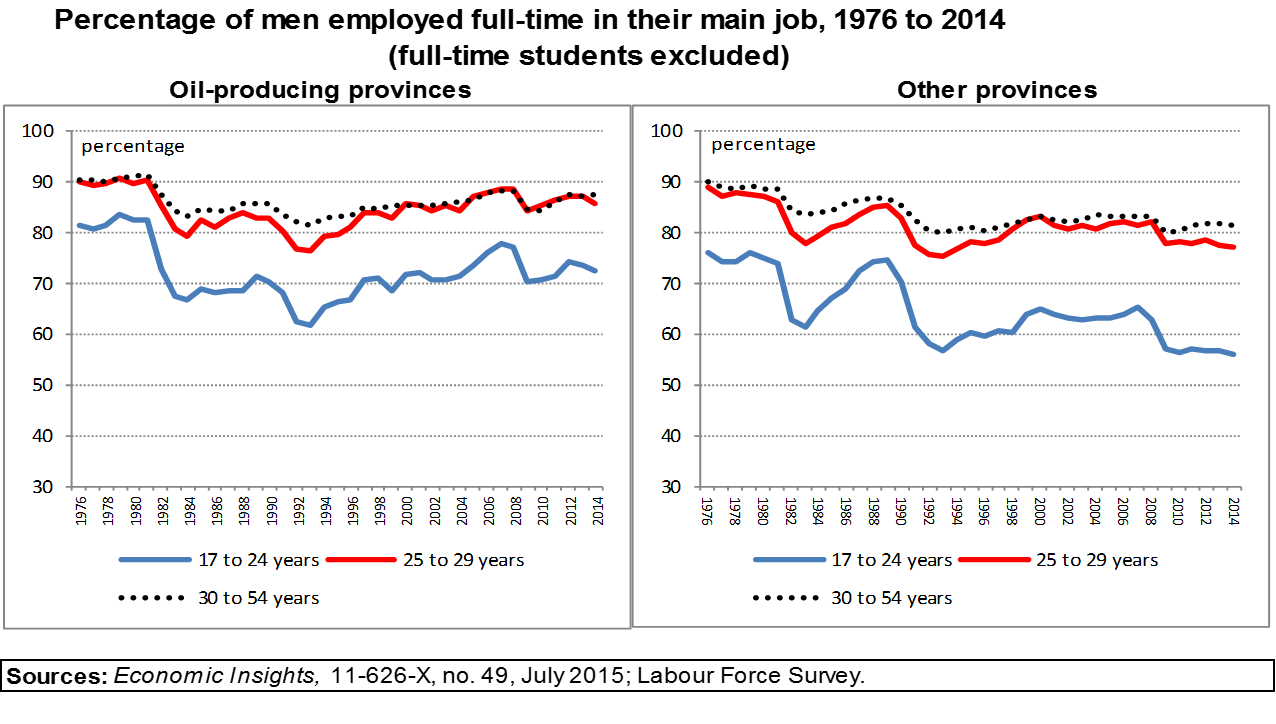
Description for Chart 12
| 17 to 24 | 25 to 29 | 30 to 54 | |
|---|---|---|---|
| Sources: Economic Insights, 11-626-X, no. 49, July 2015; Labour Force Survey. | |||
| 1976 | 81.4 | 89.9 | 90.5 |
| 1977 | 80.6 | 89.2 | 90.3 |
| 1978 | 81.3 | 89.6 | 90.0 |
| 1979 | 83.5 | 90.6 | 90.6 |
| 1980 | 82.6 | 89.8 | 91.0 |
| 1981 | 82.6 | 90.3 | 91.3 |
| 1982 | 72.8 | 85.2 | 87.6 |
| 1983 | 67.3 | 80.7 | 84.2 |
| 1984 | 66.6 | 79.3 | 83.1 |
| 1985 | 69.0 | 82.6 | 84.5 |
| 1986 | 68.1 | 81.0 | 84.3 |
| 1987 | 68.5 | 83.0 | 84.3 |
| 1988 | 68.6 | 84.0 | 85.8 |
| 1989 | 71.5 | 82.9 | 85.7 |
| 1990 | 70.4 | 83.0 | 85.6 |
| 1991 | 68.2 | 80.3 | 83.7 |
| 1992 | 62.6 | 76.7 | 82.0 |
| 1993 | 61.7 | 76.4 | 81.6 |
| 1994 | 65.2 | 79.4 | 82.7 |
| 1995 | 66.5 | 79.6 | 83.1 |
| 1996 | 66.6 | 81.0 | 83.3 |
| 1997 | 70.7 | 83.8 | 85.0 |
| 1998 | 71.0 | 83.8 | 84.8 |
| 1999 | 68.7 | 83.0 | 85.3 |
| 2000 | 71.6 | 85.9 | 85.5 |
| 2001 | 72.2 | 85.4 | 85.3 |
| 2002 | 70.5 | 84.4 | 85.4 |
| 2003 | 70.7 | 85.5 | 85.9 |
| 2004 | 71.3 | 84.3 | 86.1 |
| 2005 | 73.8 | 87.1 | 86.6 |
| 2006 | 76.1 | 87.8 | 87.8 |
| 2007 | 77.8 | 88.6 | 88.4 |
| 2008 | 77.2 | 88.6 | 88.4 |
| 2009 | 70.3 | 84.3 | 84.6 |
| 2010 | 70.8 | 85.2 | 84.3 |
| 2011 | 71.3 | 86.5 | 86.0 |
| 2012 | 74.2 | 87.1 | 87.4 |
| 2013 | 73.6 | 87.2 | 87.0 |
| 2014 | 72.5 | 85.6 | 87.5 |
| 17 to 24 | 25 to 29 | 30 to 54 | |
|---|---|---|---|
| Sources: Economic Insights, 11-626-X, no. 49, July 2015; Labour Force Survey. | |||
| 1976 | 75.9 | 88.9 | 90.0 |
| 1977 | 74.3 | 87.2 | 88.9 |
| 1978 | 74.4 | 87.8 | 88.7 |
| 1979 | 75.9 | 87.6 | 89.5 |
| 1980 | 75.1 | 87.1 | 88.7 |
| 1981 | 73.8 | 86.2 | 88.6 |
| 1982 | 62.9 | 80.0 | 84.4 |
| 1983 | 61.5 | 78.0 | 83.5 |
| 1984 | 64.5 | 79.4 | 83.8 |
| 1985 | 67.0 | 81.1 | 84.4 |
| 1986 | 69.0 | 81.8 | 85.7 |
| 1987 | 72.3 | 83.6 | 86.4 |
| 1988 | 74.2 | 85.1 | 86.8 |
| 1989 | 74.6 | 85.3 | 86.6 |
| 1990 | 70.5 | 82.8 | 85.3 |
| 1991 | 61.5 | 77.5 | 82.5 |
| 1992 | 58.3 | 75.8 | 80.5 |
| 1993 | 56.8 | 75.2 | 80.1 |
| 1994 | 59.0 | 76.8 | 80.7 |
| 1995 | 60.3 | 78.2 | 81.1 |
| 1996 | 59.8 | 78.0 | 80.4 |
| 1997 | 60.5 | 78.6 | 81.1 |
| 1998 | 60.5 | 80.6 | 81.8 |
| 1999 | 64.1 | 82.4 | 82.5 |
| 2000 | 65.0 | 83.3 | 83.2 |
| 2001 | 64.1 | 81.4 | 82.6 |
| 2002 | 63.3 | 80.9 | 82.3 |
| 2003 | 62.7 | 81.6 | 82.6 |
| 2004 | 63.1 | 80.6 | 83.6 |
| 2005 | 63.1 | 81.7 | 83.3 |
| 2006 | 64.1 | 82.1 | 83.2 |
| 2007 | 65.2 | 81.6 | 83.2 |
| 2008 | 62.9 | 82.0 | 83.1 |
| 2009 | 57.2 | 77.7 | 80.2 |
| 2010 | 56.3 | 78.1 | 80.5 |
| 2011 | 57.0 | 77.8 | 81.4 |
| 2012 | 56.7 | 78.7 | 81.6 |
| 2013 | 56.7 | 77.6 | 81.7 |
| 2014 | 56.2 | 77.2 | 81.5 |
Real wages for youth showed more variability in oil-producing provinces than in other provinces
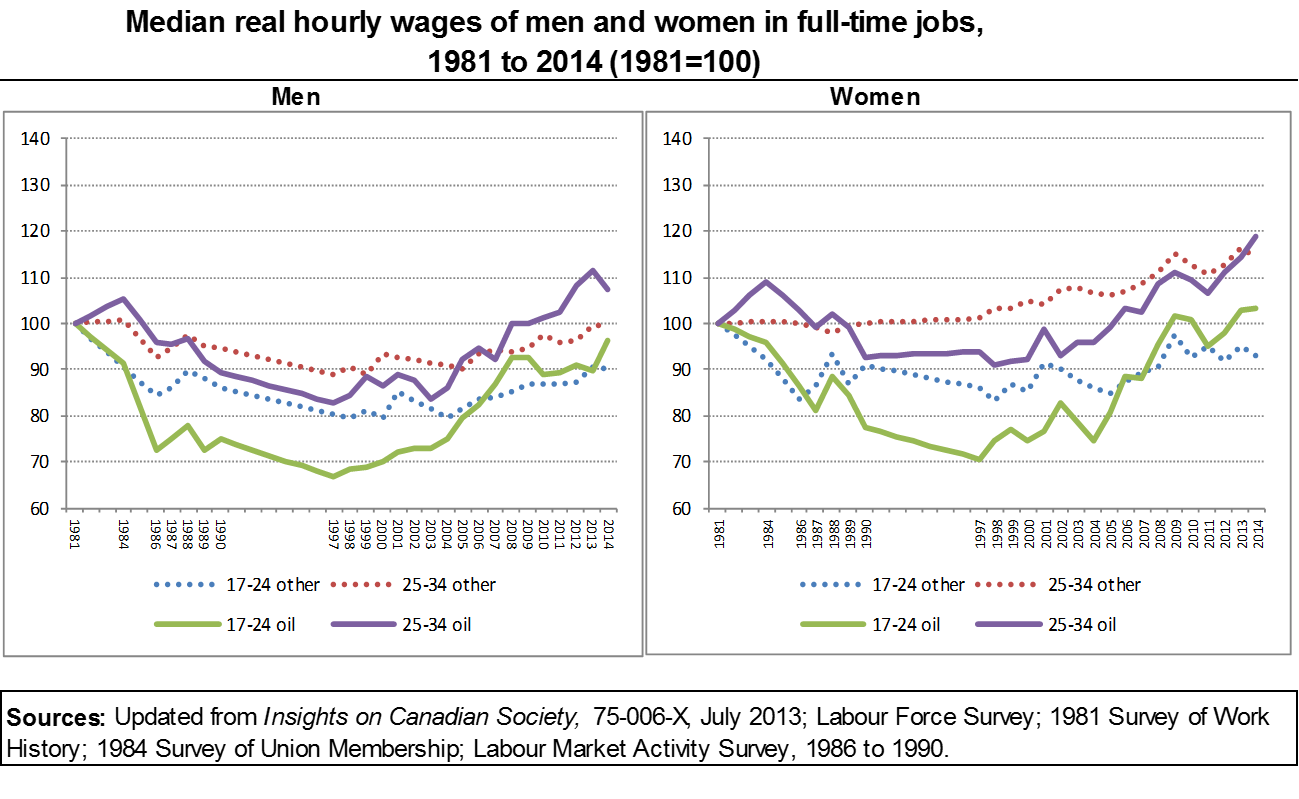
Description for Chart 13
| 17-24 other | 25-34 other | 17-24 oil | 25-34 oil | |
|---|---|---|---|---|
|
||||
| 1981 | 100.0 | 100.0 | 100.0 | 100.0 |
| 96.8Chart 13a Note 1 | 100.3Chart 13a Note 1 | 97.1Chart 13a Note 1 | 101.8Chart 13a Note 1 | |
| 93.7Chart 13a Note 1 | 100.6Chart 13a Note 1 | 94.2Chart 13a Note 1 | 103.6Chart 13a Note 1 | |
| 1984 | 90.5 | 100.9 | 91.3 | 105.5 |
| 87.5Chart 13a Note 1 | 96.8Chart 13a Note 1 | 82.0Chart 13a Note 1 | 100.7Chart 13a Note 1 | |
| 1986 | 84.5 | 92.8 | 72.7 | 96.0 |
| 1987 | 86.0 | 94.8 | 74.9 | 95.4 |
| 1988 | 89.6 | 97.5 | 77.7 | 96.6 |
| 1989 | 88.2 | 95.2 | 72.6 | 91.7 |
| 1990 | 86.1 | 94.7 | 75.0 | 89.4 |
| 85.3Chart 13a Note 1 | 93.9Chart 13a Note 1 | 73.8Chart 13a Note 1 | 88.5Chart 13a Note 1 | |
| 84.4Chart 13a Note 1 | 93.1Chart 13a Note 1 | 72.6Chart 13a Note 1 | 87.5Chart 13a Note 1 | |
| 83.6Chart 13a Note 1 | 92.3Chart 13a Note 1 | 71.5Chart 13a Note 1 | 86.6Chart 13a Note 1 | |
| 82.7Chart 13a Note 1 | 91.4Chart 13a Note 1 | 70.3Chart 13a Note 1 | 85.7Chart 13a Note 1 | |
| 81.9Chart 13a Note 1 | 90.6Chart 13a Note 1 | 69.1Chart 13a Note 1 | 84.7Chart 13a Note 1 | |
| 81.0Chart 13a Note 1 | 89.8Chart 13a Note 1 | 67.9Chart 13a Note 1 | 83.8Chart 13a Note 1 | |
| 1997 | 80.2 | 89.0 | 66.8 | 82.8 |
| 1998 | 79.5 | 90.4 | 68.5 | 84.5 |
| 1999 | 81.1 | 88.9 | 68.8 | 88.6 |
| 2000 | 79.7 | 93.6 | 70.0 | 86.5 |
| 2001 | 85.3 | 92.7 | 72.2 | 89.0 |
| 2002 | 83.4 | 92.4 | 72.8 | 87.6 |
| 2003 | 81.6 | 91.2 | 73.1 | 83.7 |
| 2004 | 79.7 | 91.0 | 75.0 | 86.0 |
| 2005 | 81.5 | 90.2 | 79.6 | 92.2 |
| 2006 | 83.6 | 93.6 | 82.5 | 94.6 |
| 2007 | 84.1 | 94.2 | 87.0 | 92.3 |
| 2008 | 85.4 | 94.0 | 92.5 | 99.9 |
| 2009 | 86.9 | 94.9 | 92.6 | 100.1 |
| 2010 | 86.7 | 97.4 | 89.0 | 101.1 |
| 2011 | 86.7 | 96.0 | 89.5 | 102.5 |
| 2012 | 87.1 | 96.2 | 91.1 | 108.0 |
| 2013 | 90.6 | 99.6 | 89.7 | 111.4 |
| 2014 | 90.3 | 99.4 | 96.3 | 107.2 |
| 17-24 other | 25-34 other | 17-24 oil | 25-34 oil | |
|---|---|---|---|---|
|
||||
| 1981 | 100.0 | 100.0 | 100.0 | 100.0 |
| 97.5Chart 13b Note 1 | 100.1Chart 13b Note 1 | 98.6Chart 13b Note 1 | 103.0Chart 13b Note 1 | |
| 94.9Chart 13b Note 1 | 100.3Chart 13b Note 1 | 97.2Chart 13b Note 1 | 106.0Chart 13b Note 1 | |
| 1984 | 92.4 | 100.4 | 95.8 | 109.0 |
| 88.0Chart 13b Note 1 | 100.2Chart 13b Note 1 | 91.2Chart 13b Note 1 | 105.9Chart 13b Note 1 | |
| 1986 | 83.7 | 100.0 | 86.7 | 102.9 |
| 1987 | 86.4 | 99.2 | 81.4 | 99.1 |
| 1988 | 93.6 | 98.0 | 88.7 | 102.2 |
| 1989 | 86.8 | 99.7 | 84.4 | 99.1 |
| 1990 | 91.0 | 100.1 | 77.5 | 92.8 |
| 90.3Chart 13b Note 1 | 100.3Chart 13b Note 1 | 76.5Chart 13b Note 1 | 92.9Chart 13b Note 1 | |
| 89.6Chart 13b Note 1 | 100.4Chart 13b Note 1 | 75.5Chart 13b Note 1 | 93.1Chart 13b Note 1 | |
| 88.9Chart 13b Note 1 | 100.5Chart 13b Note 1 | 74.5Chart 13b Note 1 | 93.3Chart 13b Note 1 | |
| 88.2Chart 13b Note 1 | 100.7Chart 13b Note 1 | 73.6Chart 13b Note 1 | 93.4Chart 13b Note 1 | |
| 87.5Chart 13b Note 1 | 100.8Chart 13b Note 1 | 72.6Chart 13b Note 1 | 93.6Chart 13b Note 1 | |
| 86.8Chart 13b Note 1 | 100.9Chart 13b Note 1 | 71.6Chart 13b Note 1 | 93.8Chart 13b Note 1 | |
| 1997 | 86.1 | 101.1 | 70.7 | 93.9 |
| 1998 | 83.1 | 103.4 | 74.4 | 90.8 |
| 1999 | 86.7 | 103.1 | 77.2 | 91.7 |
| 2000 | 85.3 | 104.8 | 74.7 | 92.2 |
| 2001 | 91.5 | 104.1 | 76.9 | 98.9 |
| 2002 | 90.1 | 107.5 | 83.0 | 92.8 |
| 2003 | 87.7 | 107.6 | 78.8 | 96.0 |
| 2004 | 86.2 | 106.4 | 74.5 | 95.9 |
| 2005 | 84.7 | 106.1 | 80.6 | 99.2 |
| 2006 | 87.5 | 107.0 | 88.5 | 103.3 |
| 2007 | 89.4 | 108.6 | 88.2 | 102.3 |
| 2008 | 90.5 | 110.8 | 95.6 | 108.6 |
| 2009 | 97.7 | 115.0 | 101.8 | 111.0 |
| 2010 | 92.8 | 112.8 | 100.8 | 109.3 |
| 2011 | 95.2 | 110.7 | 95.2 | 106.6 |
| 2012 | 91.8 | 112.8 | 98.0 | 110.9 |
| 2013 | 95.2 | 116.4 | 103.0 | 114.3 |
| 2014 | 93.0 | 114.4 | 103.2 | 118.8 |
The decline in the wage ratio for bachelor's degree holders was concentrated in the two largest oil-producing provinces of Alberta and Saskatchewan
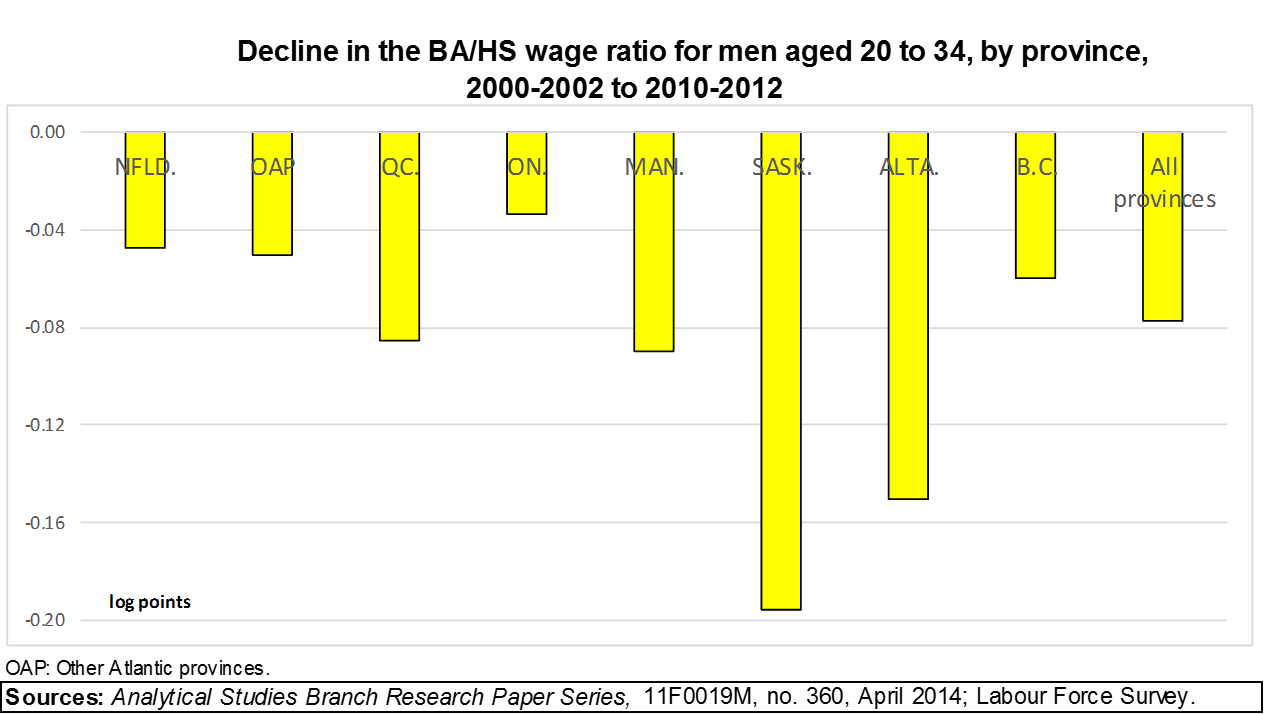
Description for Chart 14
| Wage ratio | |
|---|---|
| OAP: Other Atlantic provinces Sources: Analytical Studies Branch Research Paper Series, 11F0019M, no. 360, April 2014; Labour Force Survey. |
|
| NFLD | -0.047 |
| OAP | -0.050 |
| QC | -0.085 |
| ON | -0.034 |
| MAN | -0.090 |
| SASK | -0.196 |
| ALTA | -0.150 |
| BC | -0.060 |
| All provinces | -0.077 |
The strong wage growth observed in oil-producing provinces from the early 2000s to 2008 reduced university enrollment in these provinces but brought into the labour market some young men who were neither enrolled in school nor employed
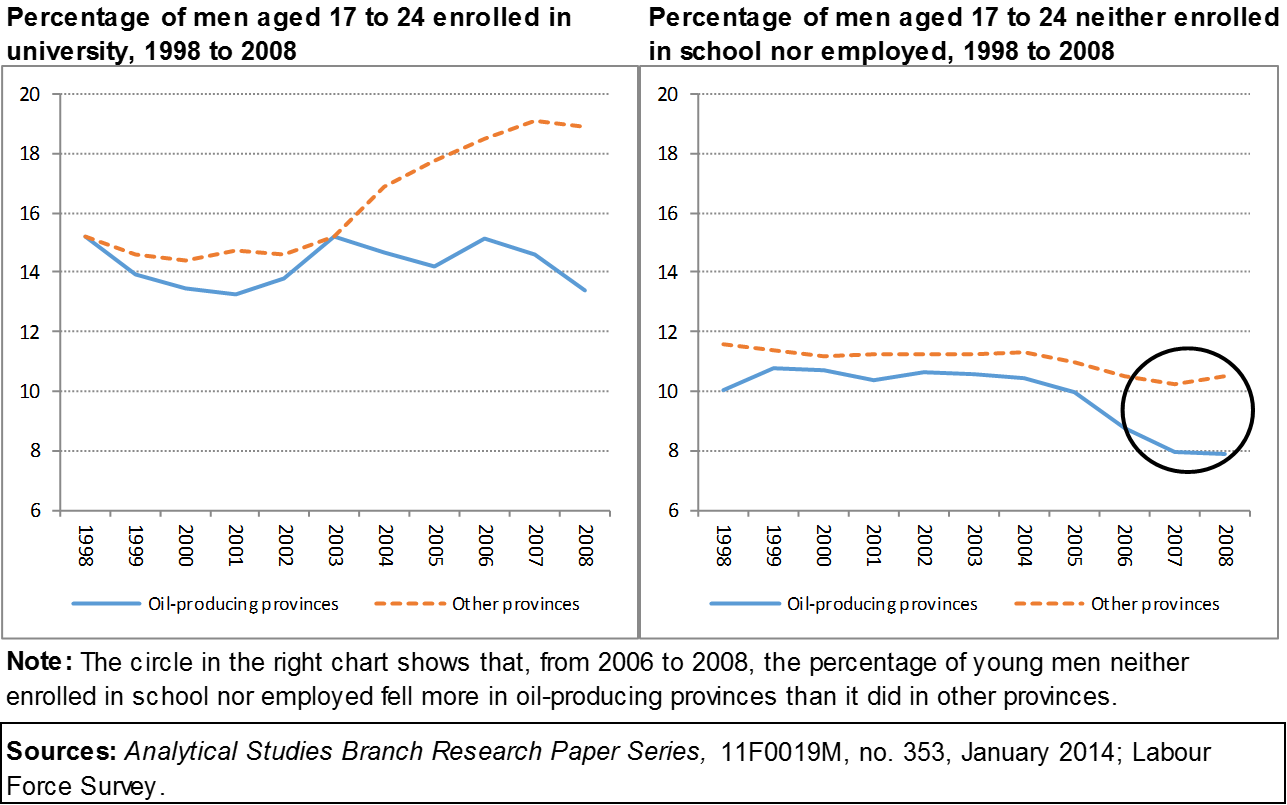
Description for Chart 15
| Oil-producing provinces | Other provinces | |
|---|---|---|
| Sources: Analytical Studies Branch Research Paper Series, 11F0019M, no. 353, January 2014; Labour Force Survey. | ||
| 1998 | 15.2 | 15.2 |
| 1999 | 14.0 | 14.6 |
| 2000 | 13.5 | 14.4 |
| 2001 | 13.3 | 14.7 |
| 2002 | 13.8 | 14.6 |
| 2003 | 15.2 | 15.2 |
| 2004 | 14.7 | 16.9 |
| 2005 | 14.2 | 17.7 |
| 2006 | 15.2 | 18.5 |
| 2007 | 14.6 | 19.1 |
| 2008 | 13.4 | 18.9 |
| Oil-producing provinces | Other provinces | |
|---|---|---|
| Note: The circle shows that from 2006 to 2008, the percentage of young men neither enrolled in school nor employed fell more in oil-producing provinces than it did in other provinces. Sources: Analytical Studies Branch Research Paper Series, 11F0019M, no. 353, January 2014; Labour Force Survey. |
||
| 1998 | 10.0 | 11.6 |
| 1999 | 10.8 | 11.4 |
| 2000 | 10.7 | 11.2 |
| 2001 | 10.4 | 11.3 |
| 2002 | 10.6 | 11.2 |
| 2003 | 10.6 | 11.3 |
| 2004 | 10.4 | 11.3 |
| 2005 | 10.0 | 11.0 |
| 2006 | 8.7 | 10.5 |
| 2007 | 7.9 | 10.3 |
| 2008 | 7.9 | 10.5 |
The oil boom has encouraged interprovincial employment
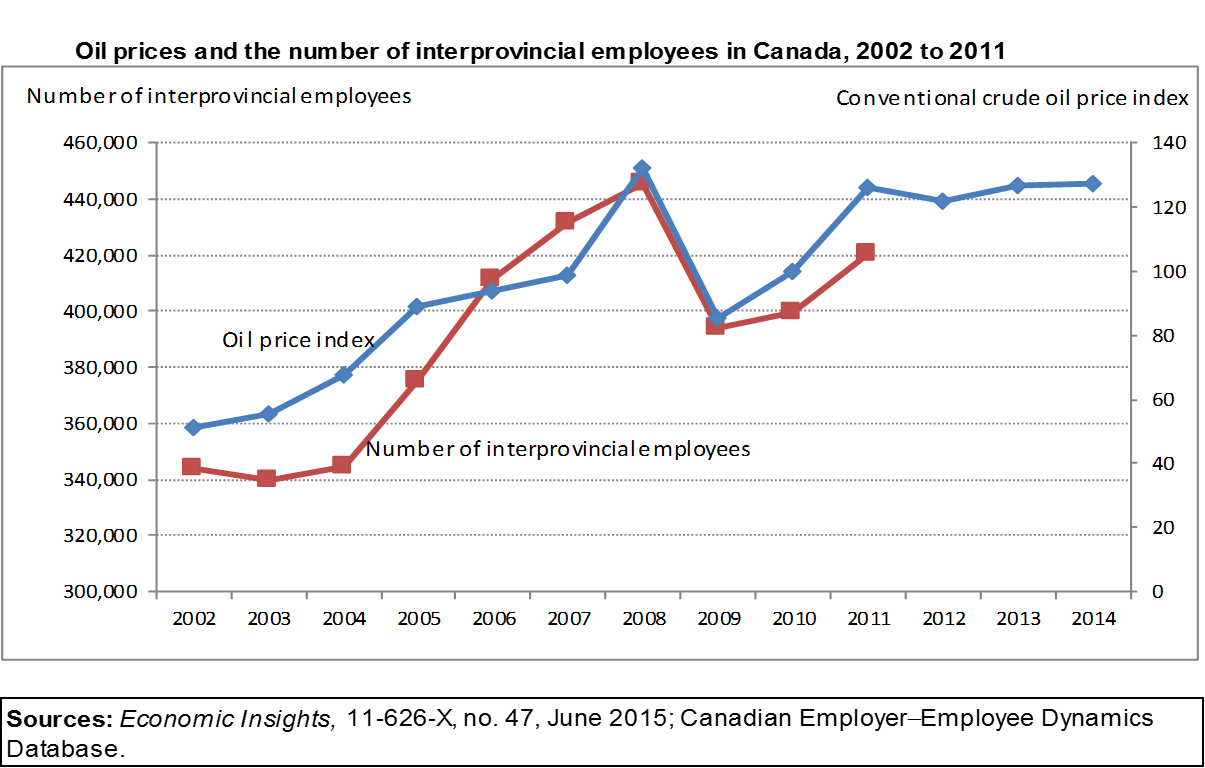
Description for Chart 16
| Oil price index | Number of inter-provincial employees | |
|---|---|---|
| Sources: Economic Insights, 11-626-X, no. 47, June 2015; Canadian Employer-Employee Dynamics Database. | ||
| 2002 | 51 | 343,788 |
| 2003 | 56 | 339,682 |
| 2004 | 68 | 344,946 |
| 2005 | 89 | 374,954 |
| 2006 | 94 | 411,645 |
| 2007 | 99 | 431,545 |
| 2008 | 132 | 445,289 |
| 2009 | 85 | 393,682 |
| 2010 | 100 | 399,623 |
| 2011 | 126 | 420,526 |
| 2012 | 122 | Not applicable ... |
| 2013 | 127 | Not applicable ... |
| 2014 | 127 | Not applicable ... |
As a result, a growing proportion of young men started a job in Alberta while maintaining residence in their home province
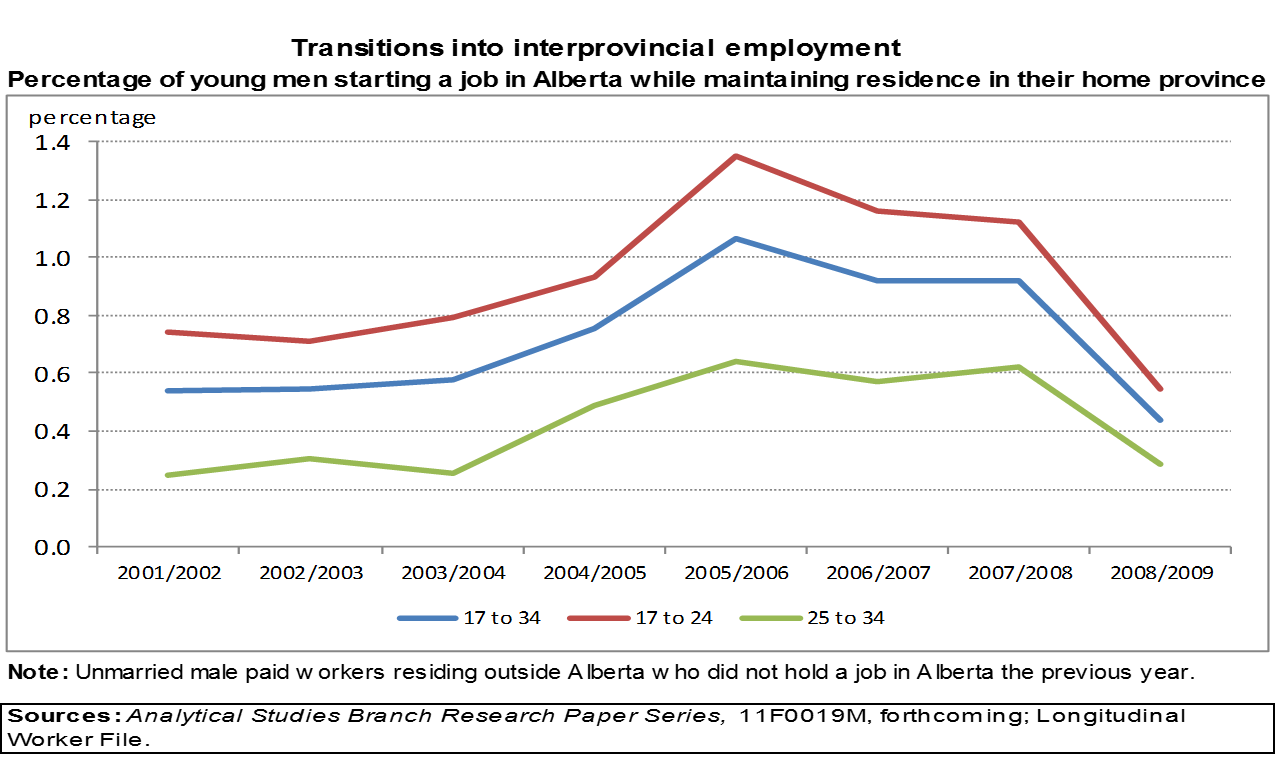
Description for Chart 17
| 17 to 34 | 17 to 24 | 25 to 34 | |
|---|---|---|---|
| Note: Unmarried male paid workers residing outside Alberta who did not hold a job in Alberta the previous year Sources: Analytical Studies Branch Research Paper Series, 11F0019M, no. 376, April 2016; Longitudinal Worker File |
|||
| 2001-2002 | 0.54 | 0.74 | 0.25 |
| 2002-2003 | 0.55 | 0.71 | 0.31 |
| 2003-2004 | 0.58 | 0.79 | 0.25 |
| 2004-2005 | 0.75 | 0.93 | 0.49 |
| 2005-2006 | 1.06 | 1.35 | 0.64 |
| 2006-2007 | 0.92 | 1.16 | 0.57 |
| 2007-2008 | 0.92 | 1.12 | 0.62 |
| 2008-2009 | 0.44 | 0.54 | 0.28 |
The oil boom also increased interprovincial mobility:
- All else equal, a 5% increase in real annual wages in Alberta relative to those in other provinces increased the propensity of young men to move to Alberta by 0.35 percentage points, from a baseline rate of about 0.65%.
- The estimated increase in the migration of young men to Alberta caused by changes in the regional earnings structure from 2001 to 2008 represents 12% to 24% of the job vacancies observed in Alberta during this period.
III. Education
Higher education generally remains associated with higher earnings and registered pension plan coverage
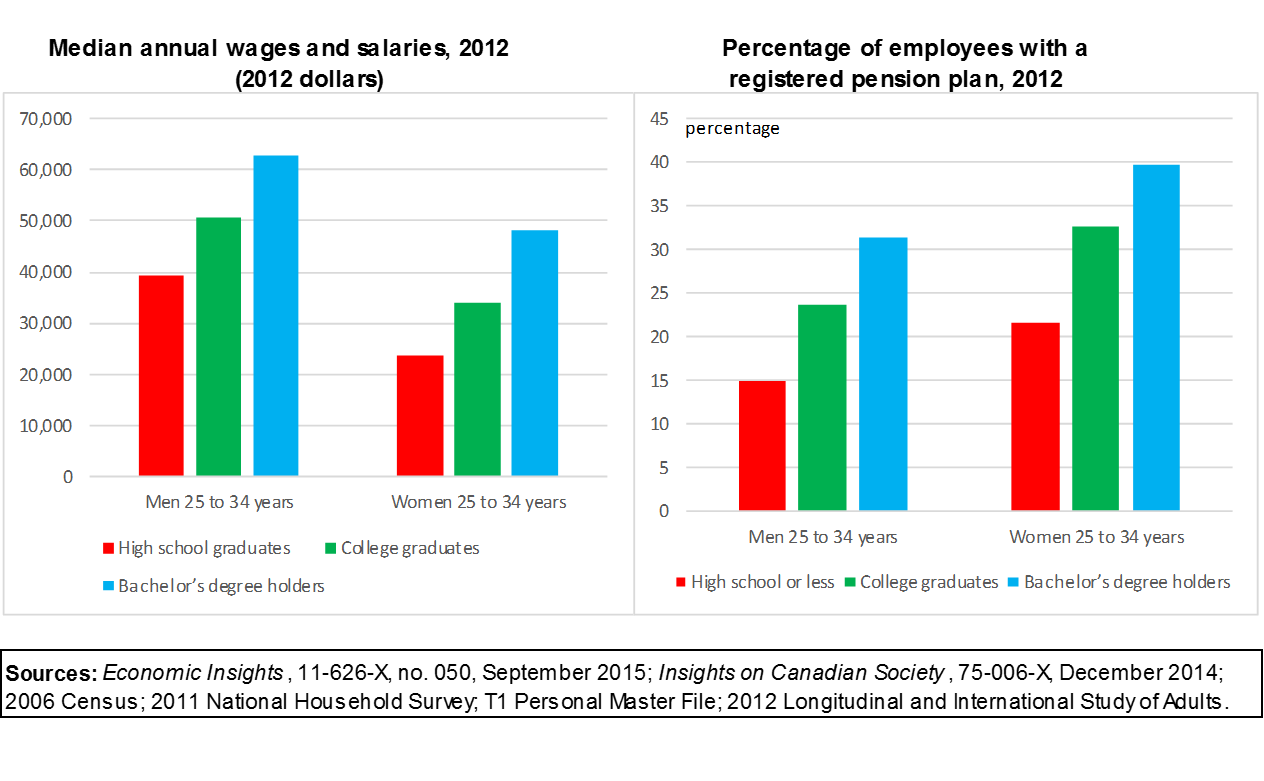
Description for Chart 18
| Men 25 to 34 years | Women 25 to 34 years | |
|---|---|---|
| Sources: Economic Insights, 11-626-X, no. 50, September 2015; Insights on Canadian Society, 75-006-X, December 2014; 2006 Census; 2011 National Household Survey; T1 Personal Master File; 2012 Longitudinal and International Study of Adults. | ||
| High school graduates | 39,230 | 23,546 |
| College graduates | 50,842 | 33,936 |
| Bachelor's degree holders | 62,626 | 48,350 |
| Men 25 to 34 years | Women 25 to 34 years | |
|---|---|---|
| Sources: Economic Insights, 11-626-X, no. 50, September 2015; Insights on Canadian Society, 75-006-X, December 2014; 2006 Census; 2011 National Household Survey; T1 Personal Master File; 2012 Longitudinal and International Study of Adults. | ||
| High school or less | 14.9 | 21.7 |
| College graduates | 23.6 | 32.6 |
| Bachelor's degree holders | 31.4 | 39.7 |
However, young men are no longer the most highly educated individuals
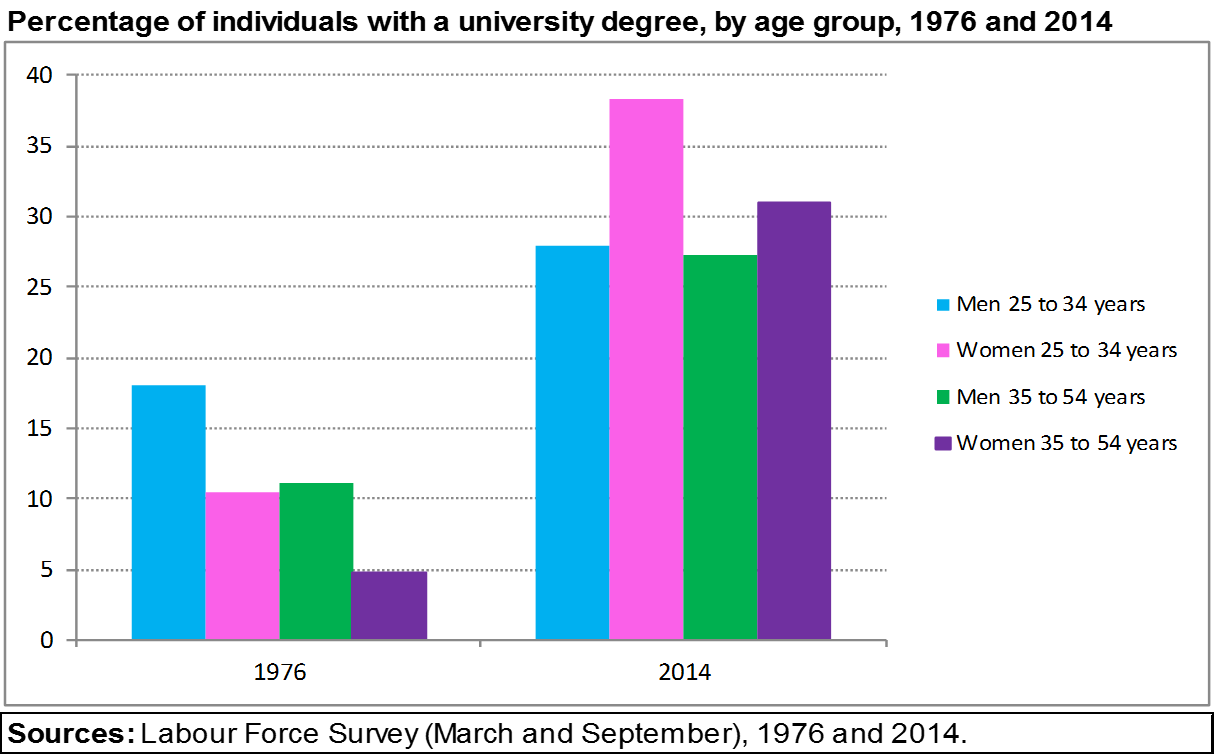
Description for Chart 19
| Men 25 to 34 years | Women 25 to 34 years | Men 35 to 54 years | Women 35 to 54 years | |
|---|---|---|---|---|
| Sources: Labour Force Survey (March and September), 1976 and 2014. | ||||
| 1976 | 18.0 | 10.5 | 11.1 | 4.8 |
| 2014 | 28.0 | 38.4 | 27.3 | 31.0 |
In some fields of study, young female bachelor's degree holders now exceed their male counterparts
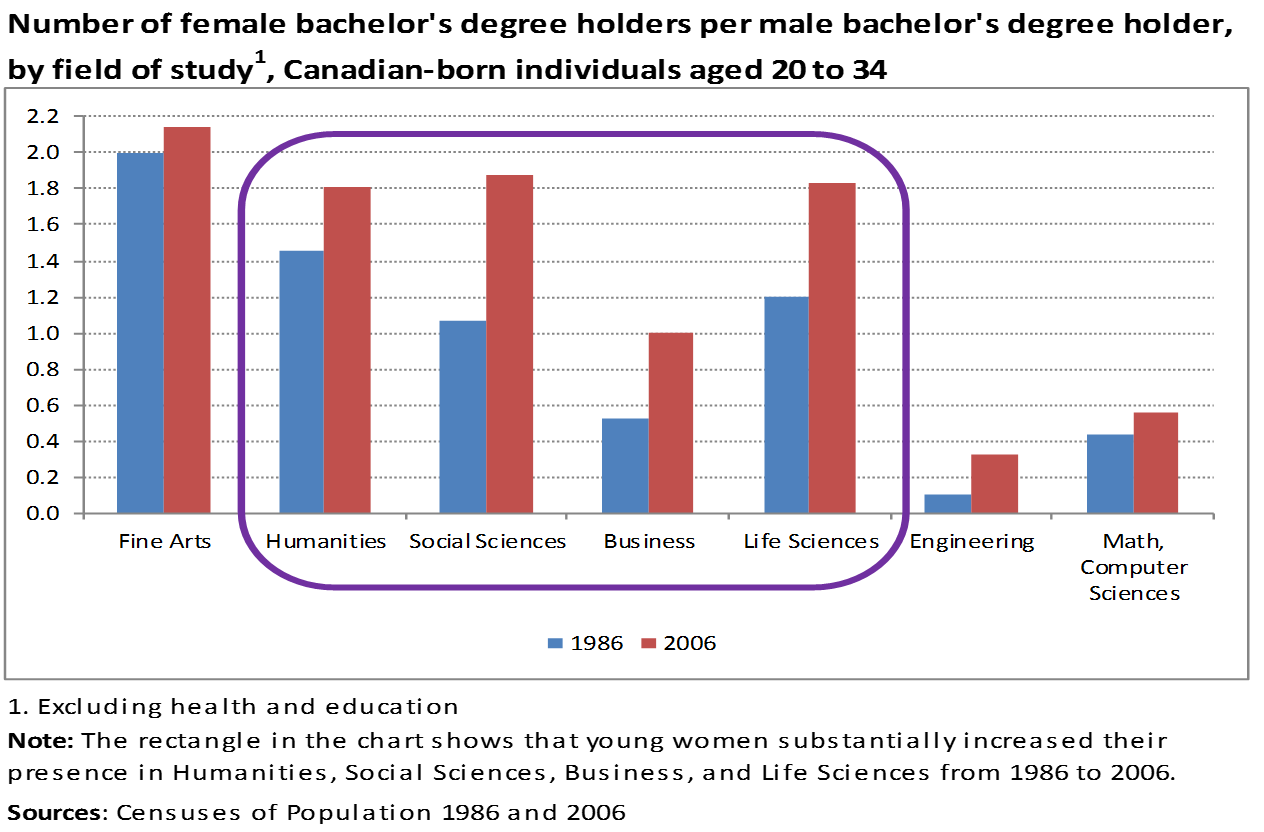
Description for Chart 20
| 1986 | 2006 | |
|---|---|---|
Sources: Censuses of Population 1986 and 2006 |
||
| Fine Arts | 2.00 | 2.14 |
| Humanities | 1.45 | 1.81 |
| Social Sciences | 1.07 | 1.87 |
| Business | 0.52 | 1.01 |
| Life Sciences | 1.20 | 1.84 |
| Engineering | 0.11 | 0.33 |
| Math, Computer Sciences | 0.44 | 0.56 |
Full-time students are more involved in the labour market today than their counterparts were in the mid-1970s
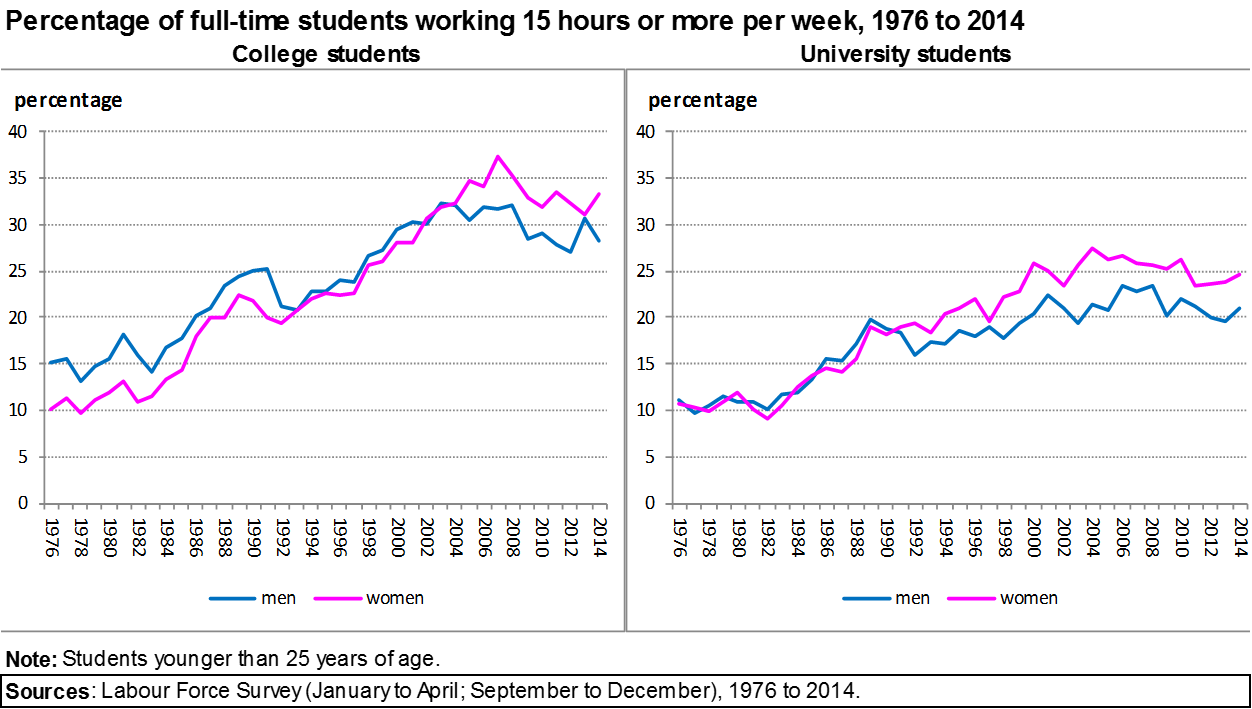
Description for Chart 21
| men | women | |
|---|---|---|
| Note: Students younger than 25. Sources: Labour Force Survey (January to April; September to December), 1976 to 2014. |
||
| 1976 | 15.1 | 10.1 |
| 1977 | 15.5 | 11.3 |
| 1978 | 13.1 | 9.8 |
| 1979 | 14.8 | 11.1 |
| 1980 | 15.6 | 11.9 |
| 1981 | 18.2 | 13.1 |
| 1982 | 15.9 | 10.8 |
| 1983 | 14.2 | 11.5 |
| 1984 | 16.8 | 13.3 |
| 1985 | 17.7 | 14.4 |
| 1986 | 20.3 | 18.0 |
| 1987 | 21.1 | 20.0 |
| 1988 | 23.4 | 20.1 |
| 1989 | 24.4 | 22.3 |
| 1990 | 25.0 | 21.8 |
| 1991 | 25.2 | 19.9 |
| 1992 | 21.2 | 19.4 |
| 1993 | 20.7 | 20.8 |
| 1994 | 22.8 | 22.0 |
| 1995 | 22.7 | 22.5 |
| 1996 | 24.0 | 22.3 |
| 1997 | 23.9 | 22.6 |
| 1998 | 26.7 | 25.6 |
| 1999 | 27.2 | 26.0 |
| 2000 | 29.4 | 28.0 |
| 2001 | 30.3 | 27.9 |
| 2002 | 29.9 | 30.7 |
| 2003 | 32.2 | 31.8 |
| 2004 | 32.1 | 32.2 |
| 2005 | 30.5 | 34.7 |
| 2006 | 31.8 | 34.1 |
| 2007 | 31.7 | 37.2 |
| 2008 | 32.1 | 35.2 |
| 2009 | 28.4 | 32.8 |
| 2010 | 28.9 | 31.9 |
| 2011 | 27.9 | 33.5 |
| 2012 | 26.9 | 32.2 |
| 2013 | 30.7 | 31.0 |
| 2014 | 28.2 | 33.2 |
| men | women | |
|---|---|---|
| Note: Students younger than 25. Sources: Labour Force Survey (January to April; September to December), 1976 to 2014. |
||
| 1976 | 11.1 | 10.6 |
| 1977 | 9.6 | 10.2 |
| 1978 | 10.6 | 9.9 |
| 1979 | 11.6 | 10.9 |
| 1980 | 10.9 | 11.9 |
| 1981 | 10.9 | 10.0 |
| 1982 | 10.0 | 9.0 |
| 1983 | 11.7 | 10.4 |
| 1984 | 11.8 | 12.5 |
| 1985 | 13.3 | 13.8 |
| 1986 | 15.6 | 14.5 |
| 1987 | 15.4 | 14.1 |
| 1988 | 17.2 | 15.6 |
| 1989 | 19.8 | 19.0 |
| 1990 | 18.7 | 18.2 |
| 1991 | 18.3 | 19.0 |
| 1992 | 16.0 | 19.3 |
| 1993 | 17.4 | 18.4 |
| 1994 | 17.1 | 20.3 |
| 1995 | 18.5 | 20.9 |
| 1996 | 18.0 | 22.0 |
| 1997 | 19.0 | 19.6 |
| 1998 | 17.7 | 22.3 |
| 1999 | 19.4 | 22.8 |
| 2000 | 20.3 | 25.7 |
| 2001 | 22.4 | 25.0 |
| 2002 | 21.0 | 23.4 |
| 2003 | 19.4 | 25.5 |
| 2004 | 21.4 | 27.4 |
| 2005 | 20.8 | 26.3 |
| 2006 | 23.5 | 26.6 |
| 2007 | 22.7 | 25.9 |
| 2008 | 23.5 | 25.6 |
| 2009 | 20.3 | 25.3 |
| 2010 | 22.1 | 26.2 |
| 2011 | 21.2 | 23.4 |
| 2012 | 20.0 | 23.6 |
| 2013 | 19.6 | 23.8 |
| 2014 | 20.9 | 24.6 |
Graduates in architecture, engineering, and related technologies generally hold jobs that require a diverse set of skills
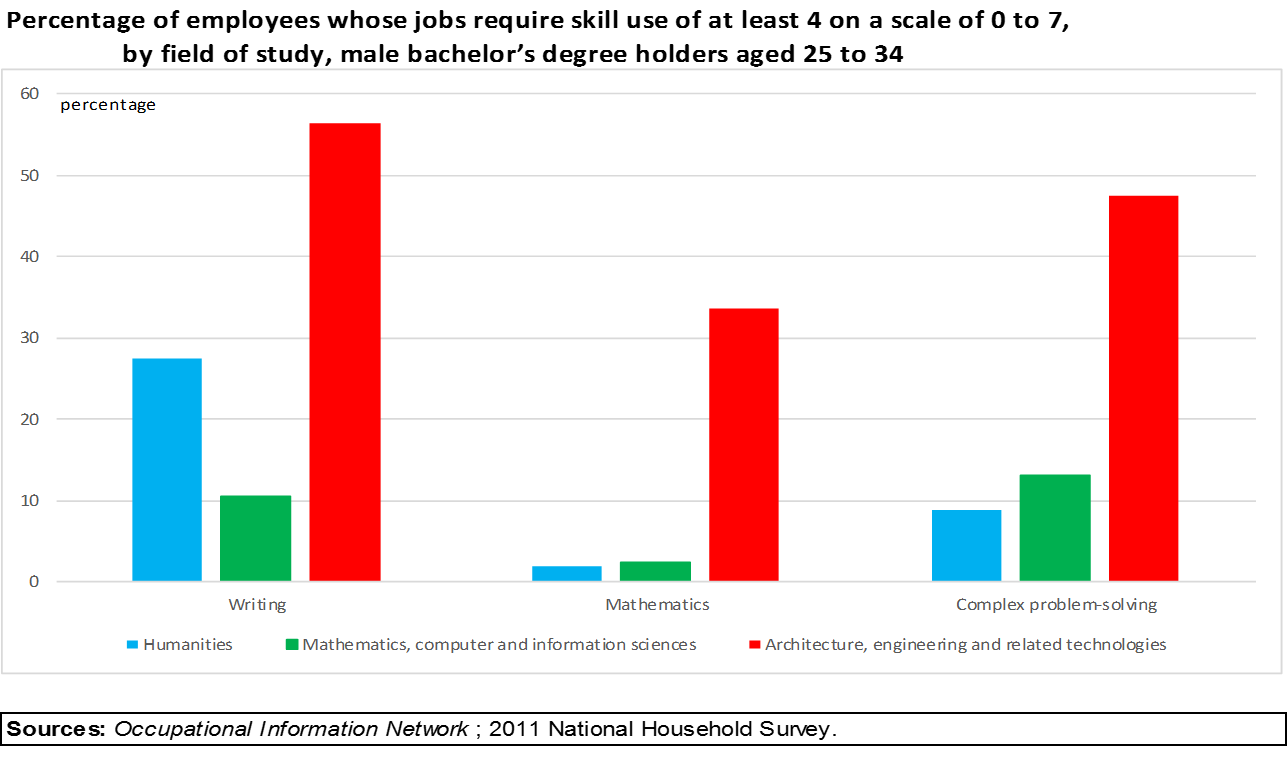
Description for Chart 22
| Humanities | Mathematics, Computer and Information Sciences | Architecture, Engineering and Related Technologies | |
|---|---|---|---|
| Sources: Occupational Information Network (ONET); 2011 National Household Survey. | |||
| Writing | 27.4 | 10.6 | 56.3 |
| Mathematics | 1.8 | 2.4 | 33.7 |
| Complex Problem Solving | 8.8 | 13.0 | 47.6 |
Private high school students attend university more often than public high school students mainly because of differences in socioeconomic characteristics and in peers
I. Percentage of youth attending university, by type of high school attended
-
- Public high school
- 45.6
-
- Private high school
- 63.4
-
- Difference
- 17.8
II. Reasons behind the difference in university attendance (proportion)
| Proportion | |
|---|---|
| Socioeconomic characteristics | 0.547 |
| Peers | 0.364 |
| Province of high school attendance | -0.009 |
| High school resources and practices | 0.123 |
| Unobserved factors | -0.025 |
| Total | 1.000 |
Note: University attendance at age 23, measured in 2008.
Sources: Economics Insights, 11-626-X, no. 44, March 2015; Analytical Studies Branch Research Paper Series, 11F019M, no. 367, March 2015; Youth in Transition Survey (YITS), Cohort A; Programme for International Student Assessment (PISA).
IV. Young Aboriginal people
The employment rates of young Aboriginal people display substantial variation
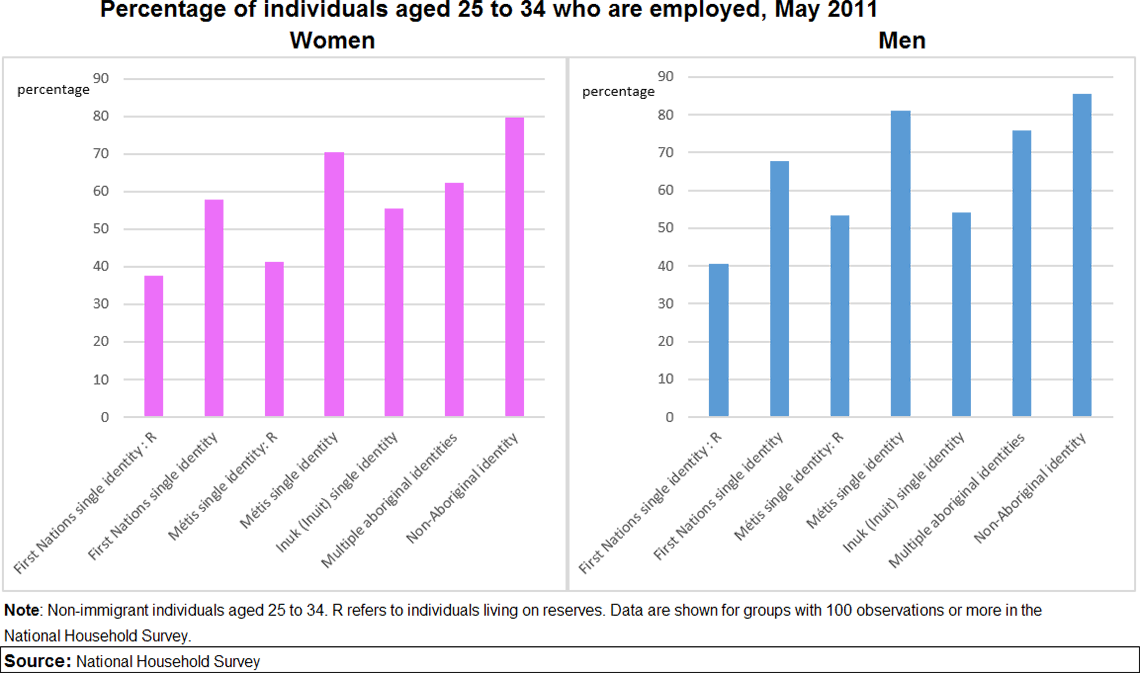
Description for Chart 23
| 25-34 | |
|---|---|
| Note: Non-immigrant individuals aged 25 to 34. R refers to individuals living on reserves. Data are shown for groups with 100 observations or more in the National Household Survey. Source: National Household Survey |
|
| First Nations single identity : R | 37.7 |
| First Nations single identity | 57.9 |
| Métis single identity: R | 41.2 |
| Métis single identity | 70.4 |
| Inuk (Inuit) single identity | 55.6 |
| Multiple aboriginal identities | 62.4 |
| Non-Aboriginal identity | 79.6 |
| 25-34 | |
|---|---|
| Note: Non-immigrant individuals aged 25 to 34. R refers to individuals living on reserves. Data are shown for groups with 100 observations or more in the National Household Survey. Source: National Household Survey |
|
| First Nations single identity : R | 40.7 |
| First Nations single identity | 67.8 |
| Métis single identity: R | 53.4 |
| Métis single identity | 81.0 |
| Inuk (Inuit) single identity | 54.2 |
| Multiple aboriginal identities | 75.9 |
| Non-Aboriginal identity | 85.5 |
Participation in extracurricular activities is associated with a greater likelihood for young First Nations people of completing high school by age 18
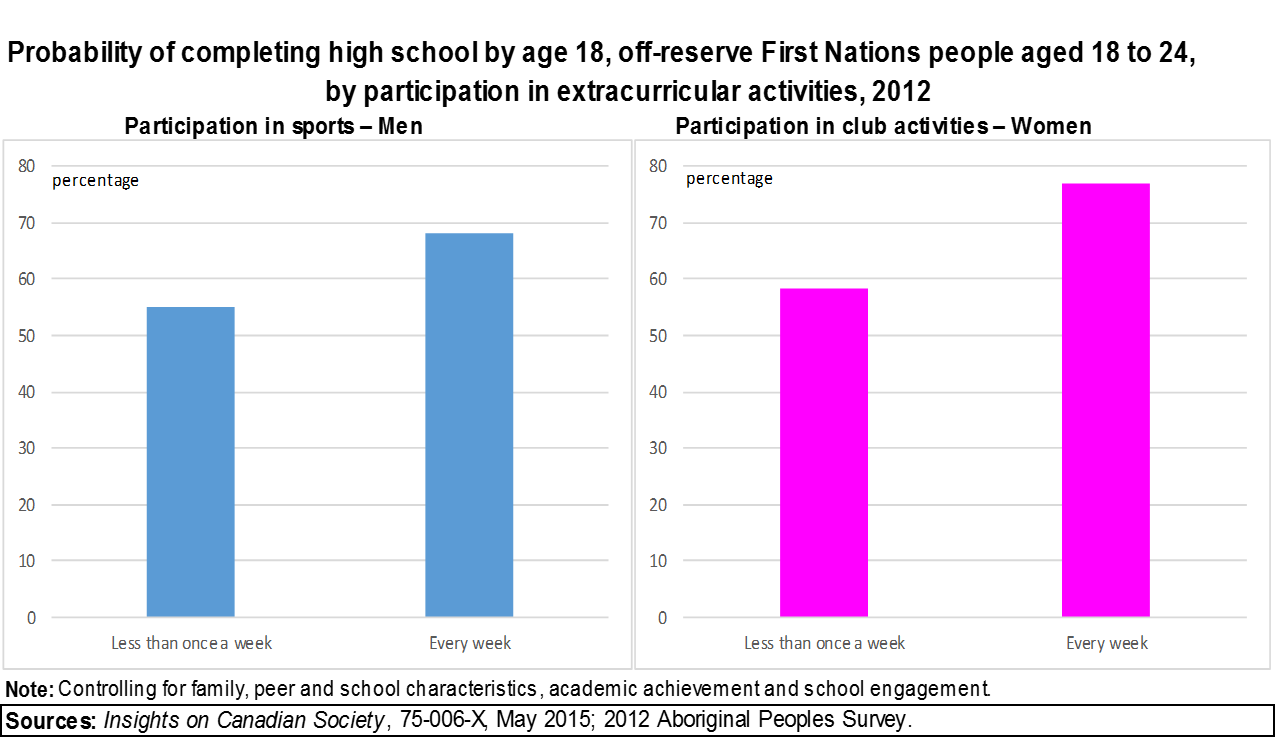
Description for Chart 24
| Percentage | |
|---|---|
| Note: Controlling for family, peer and school characteristics, academic achievement and school engagement. Sources: Insights on Canadian Society, 75-006-X, May 2015; 2012 Aboriginal Peoples Survey. |
|
| Less than once a week | 55.0 |
| Every week | 68.1 |
| Percentage | |
|---|---|
| Note: Controlling for family, peer and school characteristics, academic achievement and school engagement. Sources: Insights on Canadian Society, 75-006-X, May 2015; 2012 Aboriginal Peoples Survey. |
|
| Less than once a week | 58.4 |
| Every week | 76.8 |
V. Young immigrants
Compared with the early 1980s, proportionately fewer young immigrants have employment income two years after landing
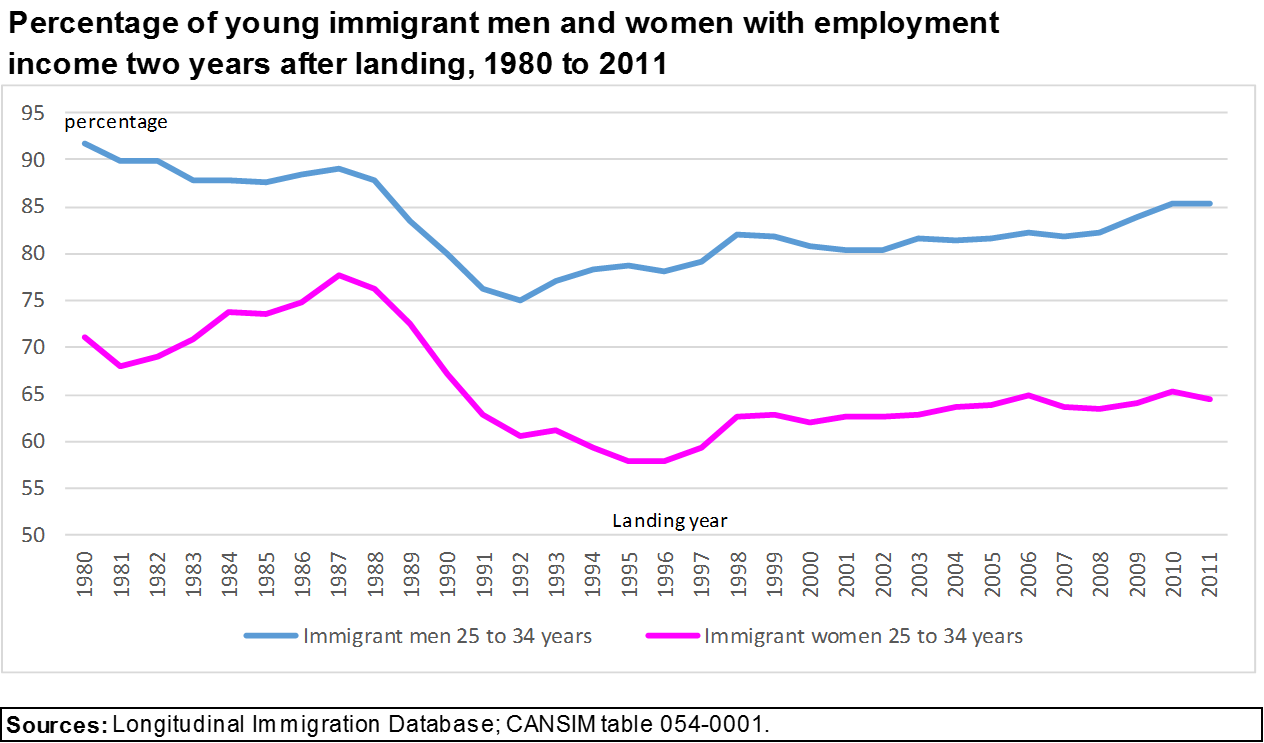
Description for Chart 25
| Immigrant men 25 to 34 years | Immigrant women 25 to 34 years | |
|---|---|---|
| Sources: Longitudinal Immigration Database; CANSIM Table 054-0001. | ||
| 1980 | 91.7 | 71.2 |
| 1981 | 89.8 | 68.0 |
| 1982 | 89.8 | 69.0 |
| 1983 | 87.8 | 71.0 |
| 1984 | 87.8 | 73.7 |
| 1985 | 87.7 | 73.7 |
| 1986 | 88.5 | 74.8 |
| 1987 | 89.1 | 77.6 |
| 1988 | 87.8 | 76.3 |
| 1989 | 83.4 | 72.6 |
| 1990 | 80.0 | 67.2 |
| 1991 | 76.2 | 62.8 |
| 1992 | 75.0 | 60.7 |
| 1993 | 77.0 | 61.3 |
| 1994 | 78.3 | 59.4 |
| 1995 | 78.7 | 58.0 |
| 1996 | 78.2 | 57.8 |
| 1997 | 79.2 | 59.4 |
| 1998 | 82.1 | 62.7 |
| 1999 | 81.8 | 62.9 |
| 2000 | 80.7 | 62.1 |
| 2001 | 80.3 | 62.6 |
| 2002 | 80.3 | 62.6 |
| 2003 | 81.6 | 62.8 |
| 2004 | 81.4 | 63.7 |
| 2005 | 81.7 | 63.9 |
| 2006 | 82.2 | 64.9 |
| 2007 | 81.9 | 63.7 |
| 2008 | 82.2 | 63.5 |
| 2009 | 83.9 | 64.1 |
| 2010 | 85.4 | 65.3 |
| 2011 | 85.3 | 64.4 |
Among young immigrants who have employment income, entry earnings have stabilized recently
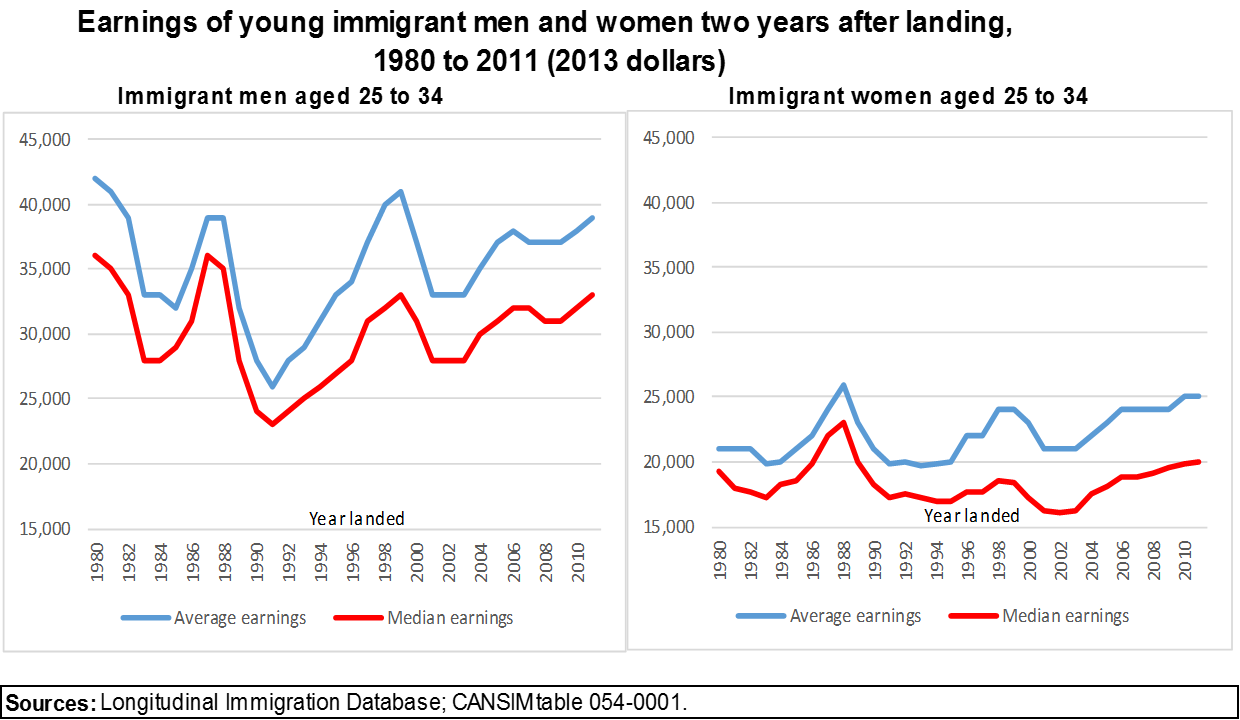
Description for Chart 26
| Average earnings | Median earnings | |
|---|---|---|
| Sources: Longitudinal Immigration Database; CANSIM Table 054-0001. | ||
| 1980 | 42,000 | 36,000 |
| 1981 | 41,000 | 35,000 |
| 1982 | 39,000 | 33,000 |
| 1983 | 33,000 | 28,000 |
| 1984 | 33,000 | 28,000 |
| 1985 | 32,000 | 29,000 |
| 1986 | 35,000 | 31,000 |
| 1987 | 39,000 | 36,000 |
| 1988 | 39,000 | 35,000 |
| 1989 | 32,000 | 28,000 |
| 1990 | 28,000 | 24,000 |
| 1991 | 26,000 | 23,000 |
| 1992 | 28,000 | 24,000 |
| 1993 | 29,000 | 25,000 |
| 1994 | 31,000 | 26,000 |
| 1995 | 33,000 | 27,000 |
| 1996 | 34,000 | 28,000 |
| 1997 | 37,000 | 31,000 |
| 1998 | 40,000 | 32,000 |
| 1999 | 41,000 | 33,000 |
| 2000 | 37,000 | 31,000 |
| 2001 | 33,000 | 28,000 |
| 2002 | 33,000 | 28,000 |
| 2003 | 33,000 | 28,000 |
| 2004 | 35,000 | 30,000 |
| 2005 | 37,000 | 31,000 |
| 2006 | 38,000 | 32,000 |
| 2007 | 37,000 | 32,000 |
| 2008 | 37,000 | 31,000 |
| 2009 | 37,000 | 31,000 |
| 2010 | 38,000 | 32,000 |
| 2011 | 39,000 | 33,000 |
| Average earnings | Median earnings | |
|---|---|---|
| Sources: Longitudinal Immigration Database; CANSIM Table 054-0001. | ||
| 1980 | 21,000 | 19,300 |
| 1981 | 21,000 | 18,000 |
| 1982 | 21,000 | 17,700 |
| 1983 | 19,800 | 17,200 |
| 1984 | 20,000 | 18,300 |
| 1985 | 21,000 | 18,600 |
| 1986 | 22,000 | 19,900 |
| 1987 | 24,000 | 22,000 |
| 1988 | 26,000 | 23,000 |
| 1989 | 23,000 | 20,000 |
| 1990 | 21,000 | 18,200 |
| 1991 | 19,900 | 17,300 |
| 1992 | 20,000 | 17,600 |
| 1993 | 19,700 | 17,300 |
| 1994 | 19,900 | 16,900 |
| 1995 | 20,000 | 17,000 |
| 1996 | 22,000 | 17,700 |
| 1997 | 22,000 | 17,700 |
| 1998 | 24,000 | 18,500 |
| 1999 | 24,000 | 18,400 |
| 2000 | 23,000 | 17,300 |
| 2001 | 21,000 | 16,300 |
| 2002 | 21,000 | 16,100 |
| 2003 | 21,000 | 16,200 |
| 2004 | 22,000 | 17,500 |
| 2005 | 23,000 | 18,100 |
| 2006 | 24,000 | 18,800 |
| 2007 | 24,000 | 18,900 |
| 2008 | 24,000 | 19,100 |
| 2009 | 24,000 | 19,500 |
| 2010 | 25,000 | 19,900 |
| 2011 | 25,000 | 20,000 |
The superior educational outcomes of the children of immigrants remain evident in 2011
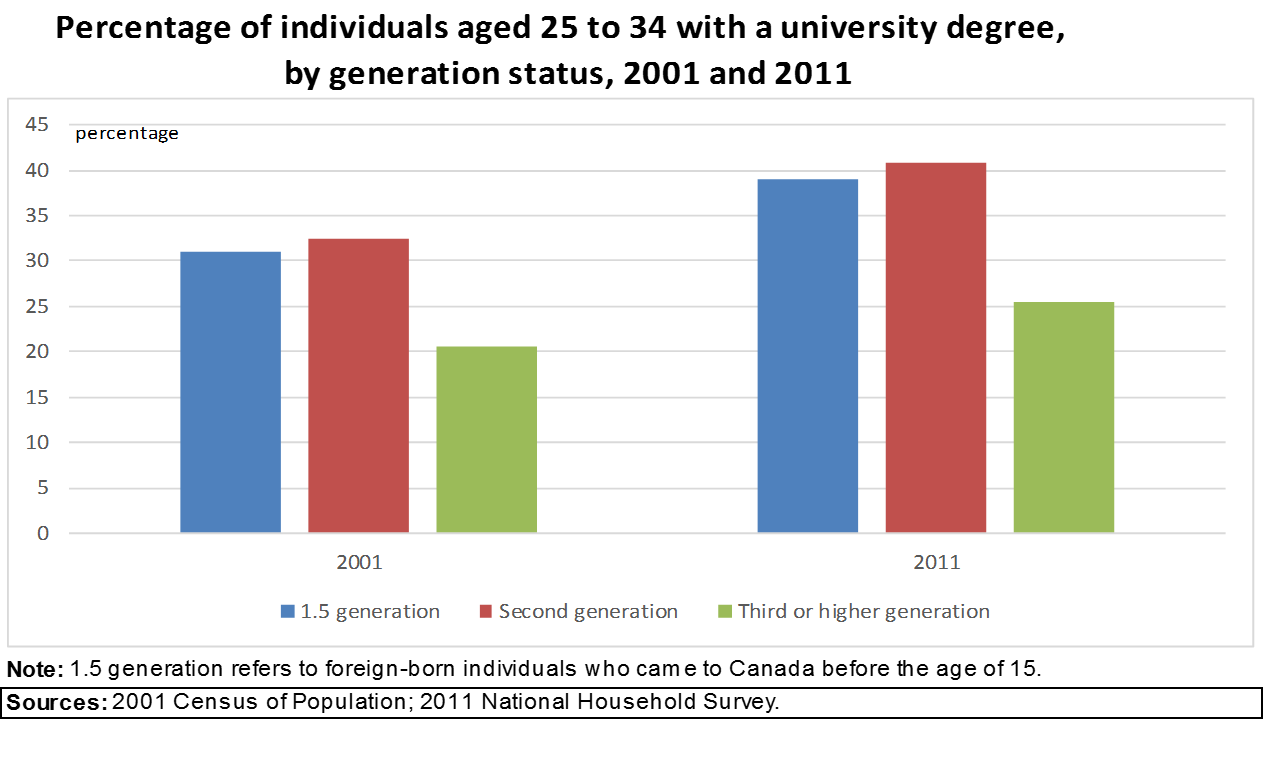
Description for Chart 27
| 2001 | 2011 | |
|---|---|---|
| Note: 1.5 generation refers to foreign-born individuals who came to Canada before the age of 15. Sources: 2001 Census of Population; 2011 National Household Survey. |
||
| 1.5 generation | 31.0 | 39.0 |
| Second generation | 32.5 | 40.9 |
| Third or higher generation | 20.6 | 25.5 |
However, evidence of labour-market advantages for the children of immigrants (over the higher generations) is no longer seen in 2011
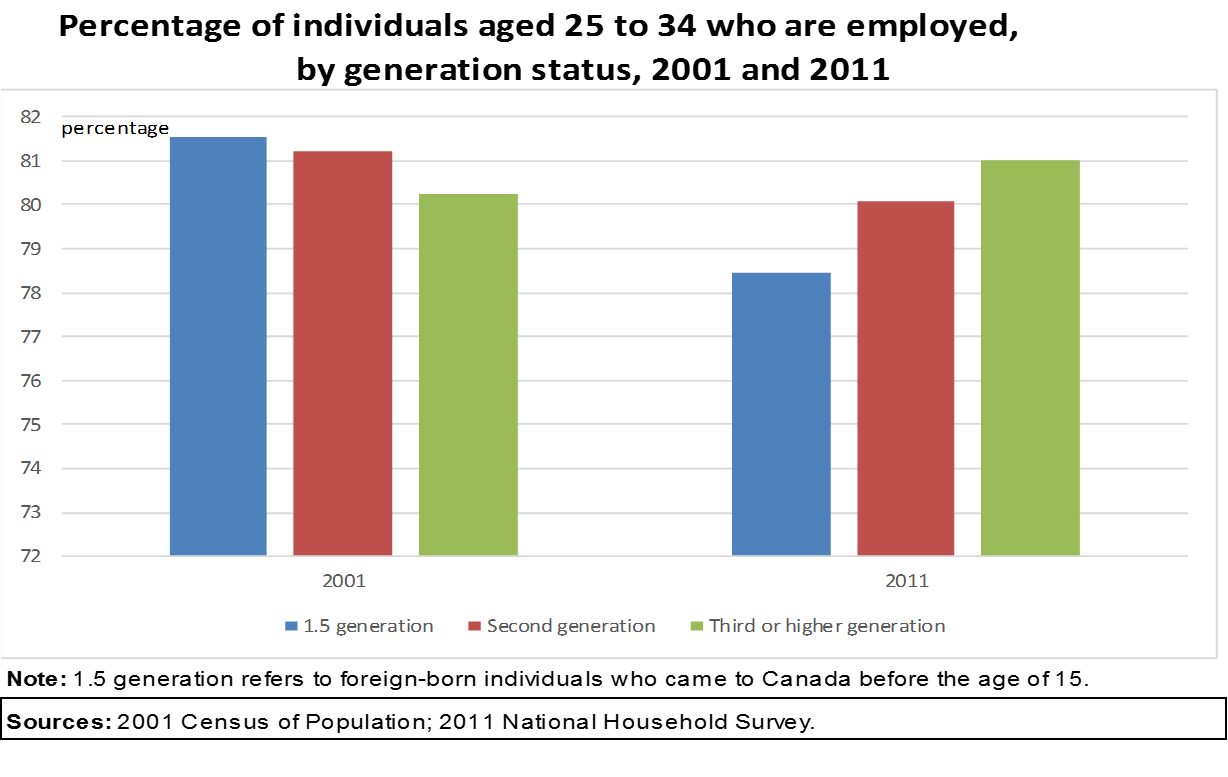
Description for Chart 28
| 2001 | 2011 | |
|---|---|---|
| Note: 1.5 generation refers to foreign-born individuals who came to Canada before the age of 15. Sources: 2001 Census of Population; 2011 National Household Survey. |
||
| 1.5 generation | 81.5 | 78.5 |
| Second generation | 81.2 | 80.1 |
| Third or higher generation | 80.2 | 81.0 |
Young immigrant wives participate less in the Canadian labour market than their Canadian-born counterparts
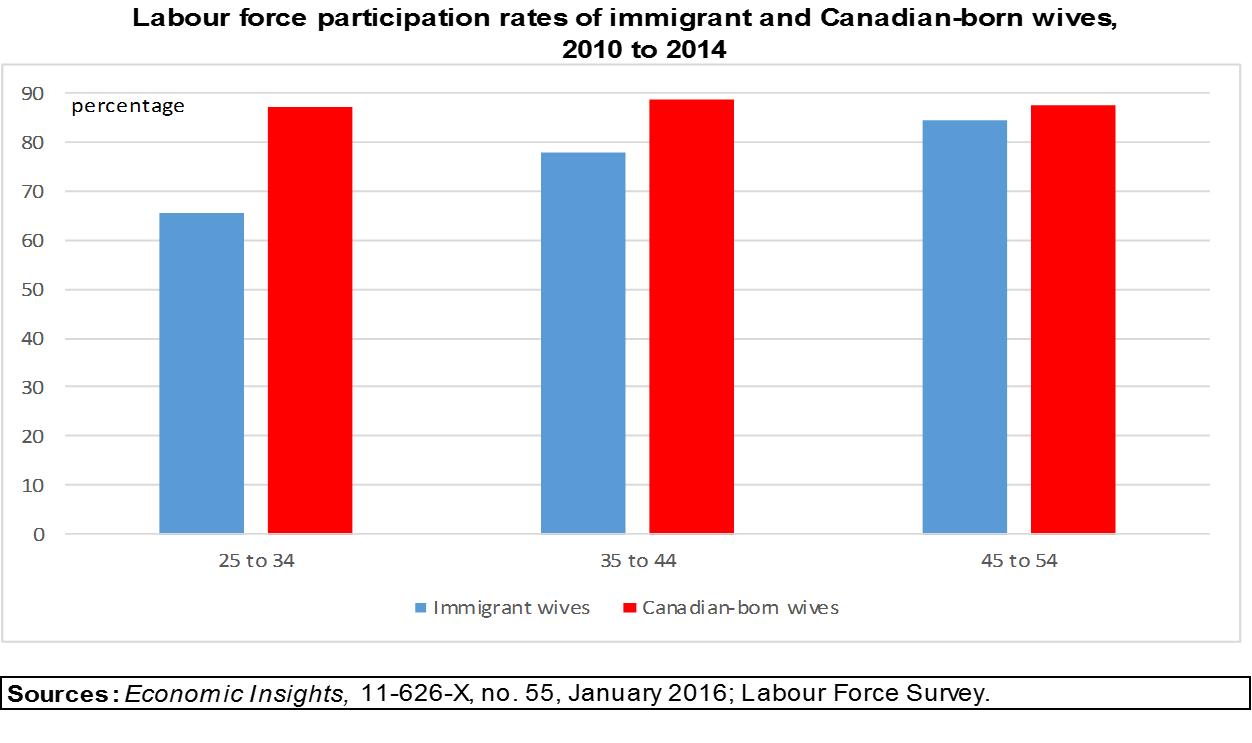
Description for Chart 29
| Immigrant wives | Canadian-born wives | |
|---|---|---|
| Sources: Economic Insights, 11-626-X, no. 55, January 2016; Labour Force Survey. | ||
| 25 to 34 | 65.6 | 87.2 |
| 35 to 44 | 77.9 | 88.6 |
| 45 to 54 | 84.3 | 87.6 |
Large regional differences in the educational outcomes of young immigrants who came to Canada before the age of 15
| PISA math score, age 15 | PISA reading score, age 15 | University completion, age 25 to 29, % | ||||
|---|---|---|---|---|---|---|
| Third-or-higher generation | Childhood immigrants | Third-or-higher generation | Childhood immigrants | Third-or-higher generation | Childhood immigrants | |
| Sources: Insights on Canadian Society, 75-006X, November 2015; 2011 National Household Survey; Programme for International Student Assessment (PISA). | ||||||
| Canada | 529 | 530 | 532 | 517 | 25.7 | 39.9 |
| Atlantic | 505 | 531 | 508 | 508 | 26.1 | 37.8 |
| Quebec | 545 | 508 | 536 | 485 | 24.8 | 32.0 |
| Ontario | 526 | 532 | 536 | 523 | 28.1 | 40.9 |
| Manitoba and Saskatchewan | 514 | 494 | 522 | 477 | 22.0 | 29.3 |
| Alberta | 536 | 527 | 540 | 527 | 21.4 | 34.9 |
| British Columbia | 526 | 554 | 534 | 523 | 20.9 | 43.5 |
Summary
- Youth unemployment today is similar to that of the mid-1970s.
- However, job quality appears to have deteriorated for many young people.
- Full-time employment rates and the percentage of full-time jobs that are permanent have fallen for men under 35, for older men, and for women under 25.
- Wages have fallen for men and women under 25.
- Pension coverage has fallen for men aged 25 to 34, as well as for older men.
- The degree to which globalization, technological changes, de-unionization and labour supply shifts underlie these changes is difficult to quantify.
- A substantial gender difference in university attendance has emerged.
- Trends have varied by region, and new patterns are emerging for young immigrants.
- Date modified:
